Select a theme to learn more
Select an image to learn more
Torah Binder
A Torah binder keeps the Torah closed when it is not in use. Different traditions of its form and decoration have arisen in various communities. For example, in Germanic (Ashkenazi) lands the swaddling cloth for the circumcision ceremony of a male child was used, decorated with words and images that wish him well, In Italy women embroidered floral patterns and sometimes inscriptions on a length of cloth, expressing hopes and thanks for important events. Often, the insides of letters are executed in exuberant patterns and vibrant colors, and the binders are ornamented with imagery related to the child.
Shofars
Going back to ancient times, musical instruments made from animal horns were blown to announce the onset of important events such as the Jubilee year and the Jewish New Year. Today, the shofar is used primarily during the new year holy days of Rosh Hashanah and Yom Kippur, when it is blown one hundred times during services.
Shofars
Going back to ancient times, musical instruments made from animal horns were blown to announce the onset of important events such as the Jubilee year and the Jewish New Year. Today, the shofar is used primarily during the new year holy days of Rosh Hashanah and Yom Kippur, when it is blown one hundred times during services.
Shofars
Going back to ancient times, musical instruments made from animal horns were blown to announce the onset of important events such as the Jubilee year and the Jewish New Year. Today, the shofar is used primarily during the new year holy days of Rosh Hashanah and Yom Kippur, when it is blown one hundred times during services.
Shofars
Going back to ancient times, musical instruments made from animal horns were blown to announce the onset of important events such as the Jubilee year and the Jewish New Year. Today, the shofar is used primarily during the new year holy days of Rosh Hashanah and Yom Kippur, when it is blown one hundred times during services.
Ship Model
Traditional cabinets of wonders often feature beautifully made objects, cunningly made, frequently of precious materials. Like many institutions with a broad mission—focusing on art, but with strong attention to culture and history—the Jewish Museum has acquired an eclectic range of objects. The two model ships in this room were commissioned for exhibitions on the antiquities of Israel. Long since detached from that purpose, they remain works of fine craftsmanship, resonant with a sense of the distant past—both that of the Mideast and that of the museum.
Prayer Book Covers and Jewelry
Prayer books and Bibles have often been given as gifts, sometimes between affianced couples. Finely crafted book bindings made of precious materials signal both the status of the owner and the great value of the book. At the other extreme, the invention of celluloid in the second half of the nineteenth century soon led to its use for book covers, providing an inexpensive, durable imitation of ivory. Novelty items such as miniature Hebrew Bibles became popular in the late nineteenth century, after the invention of microphotography.
Since antiquity jewelry has played a social role beyond mere adornment. Gold and gems convey economic status, whether in the ancient Mideast or today. In Ottoman Iraq, a bride-to-be received a diamond pin from her fiancé, while in the twentieth century women proudly wore gold-plated pins signaling that they had raised funds for Israel Bonds after the formation of that state.
Prayer Book Covers
Prayer books and Bibles have often been given as gifts, sometimes between affianced couples. Finely crafted book bindings made of precious materials signal both the status of the owner and the great value of the book. At the other extreme, the invention of celluloid in the second half of the nineteenth century soon led to its use for book covers, providing an inexpensive, durable imitation of ivory. Novelty items such as miniature Hebrew Bibles became popular in the late nineteenth century, after the invention of microphotography.
Clay and Timepieces
Clay was the earliest plastic material fashioned by humans into vessels and figures. When fired, it can last for millennia, and is the most ubiquitous object material found by archaeologists as well as the most useful for dating sites. A series of oil lamps shown here demonstrates the technological progression in form and size from the large open bowl-shaped examples to smaller mold-made lamps with small fill and wick holes to prevent oil spillage.
Clocks and watches with Hebrew dials became popular in the late nineteenth and early twentieth centuries, probably as an overt expression of Jewish identity. Some of the clocks may have been inspired by the founding of the Zionist movement at the end of the nineteenth century, since they bear Jewish stars with the word Zion in the center or images of Theodor Herzl, the movement’s founder. Other clocks have music boxes in their bases. An unusual timekeeper is a small perpetual calendar in Hebrew, made as a button to be sewn onto clothing.
Glass
The Levantine coast from Syria to Israel was a major center of glassmaking in the first millennium. The earliest evidence of blown glass, as opposed to molten glass formed around a core or pressed into a mold, dates to the first century BCE in Israel. Clear, colorless glass was at first difficult to produce and was prized, but by the first century CE it had become common.
Torah Pointers
The sanctity of the Torah scroll is so great that those reading it to the congregation in synagogue should not touch the text. Since it is crucial that the reader not lose his or her place, a rod is used, often with a little hand at one end, guiding finger extended.
Purim Noisemakers
During the holiday of Purim, the book of Esther is read aloud in synagogue. Every time Haman, the villain of the story, is mentioned, the entire congregation uses noisemakers to drown out his name, as well as stamping on the floor. Noisemakers, sometimes called groggers, come in various forms, usually with ratchets or clappers.
Timepieces
Clocks and watches with Hebrew dials became popular in the late nineteenth and early twentieth centuries, probably as an overt expression of Jewish identity. Some of the clocks may have been inspired by the founding of the Zionist movement at the end of the nineteenth century, since they bear Jewish stars with the word Zion in the center or images of Theodor Herzl, the movement’s founder. Other clocks have music boxes in their bases. An unusual timekeeper is a small perpetual calendar in Hebrew, made as a button to be sewn onto clothing.
Work
Torah binder of Yehiel Mikhel, son of Shimshon
Date
1778 (date of inscription)
Artist
Unknown
Place Made
Germany or Bohemia (present-day Czech Republic)
Medium
Block-printed linen
Credit Line
The Rose and Benjamin Mintz Collection, M 97
A professional block printer stamped the motifs and lettering on the border and central panel of this binder. Block-printed textiles were popular in eighteenth-century Europe, where printers strove to improve methods to compete with imported Indian goods. Some Hebrew letters in the inscription have crowns above them, indicating abbreviations.
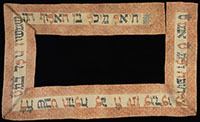
Work
Shofar
Date
Eighteenth or nineteenth century?
Artist
Unknown
Place Made
Europe or Asia?
Medium
Ram’s horn
Credit Line
Gift of Dr. Harry G. Friedman, F 5496

Work
Shofar
Date
Nineteenth century
Artist
Unknown
Place Made
Europe?
Medium
Ram’s horn
Credit Line
Gift of Judge Mayer Sulzberger, S 506

Work
Shofar
Date
1743–44
Artist
Unknown
Place Made
Germany?
Medium
Engraved ram’s horn
Credit Line
Gift of Dr. Harry G. Friedman, F 471

Work
Shofar
Date
Nineteenth or early twentieth century
Artist
Unknown
Place Made
Europe
Medium
Ram’s horn
Credit Line
Gift of Dr. Harry G. Friedman, F 4807
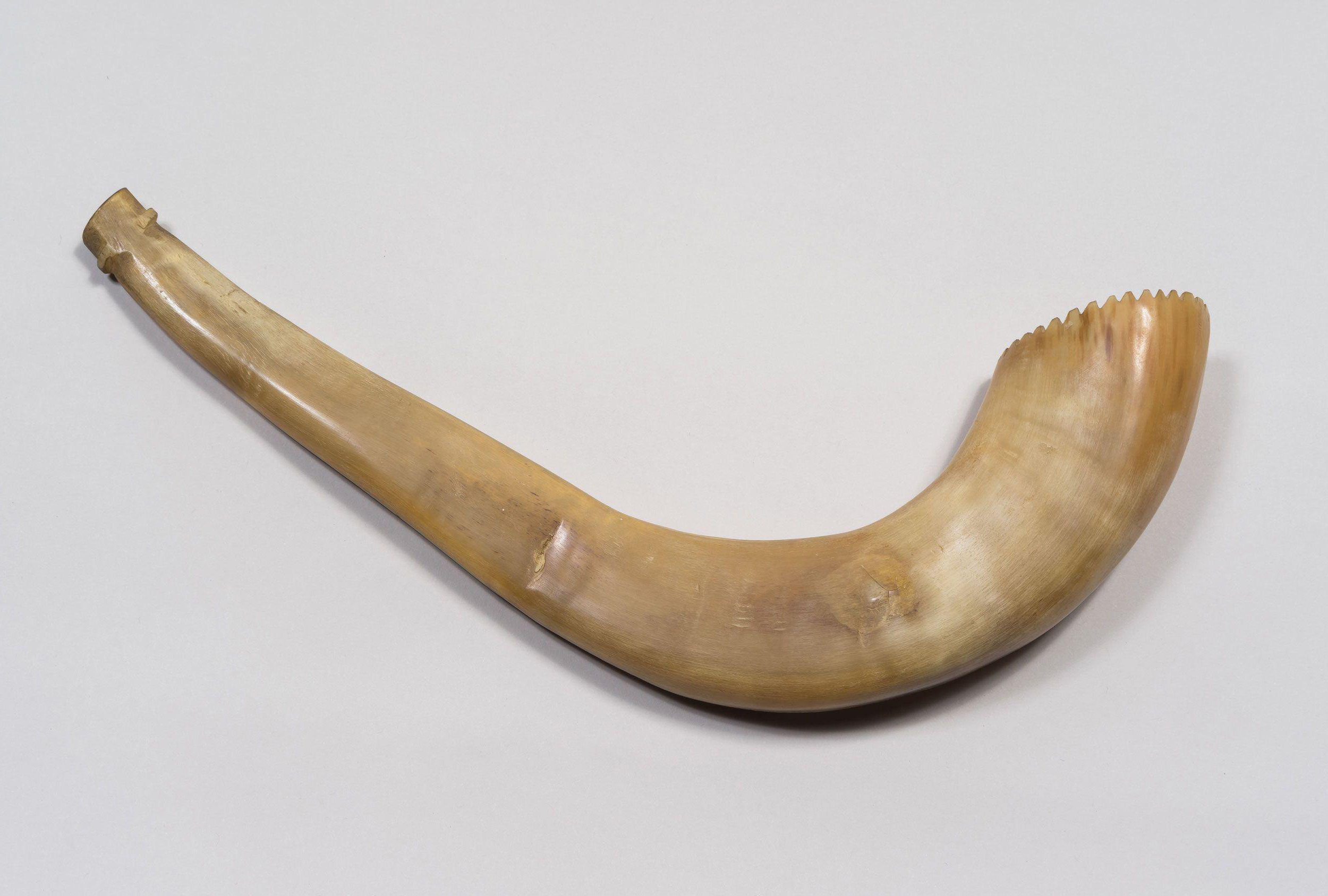
Work
Shofar
Date
1781–82
Artist
Unknown
Place Made
Dieburg, Germany
Medium
Engraved ram’s horn
Credit Line
Gift of Carrie Bachrach Abraham, JM 2-49
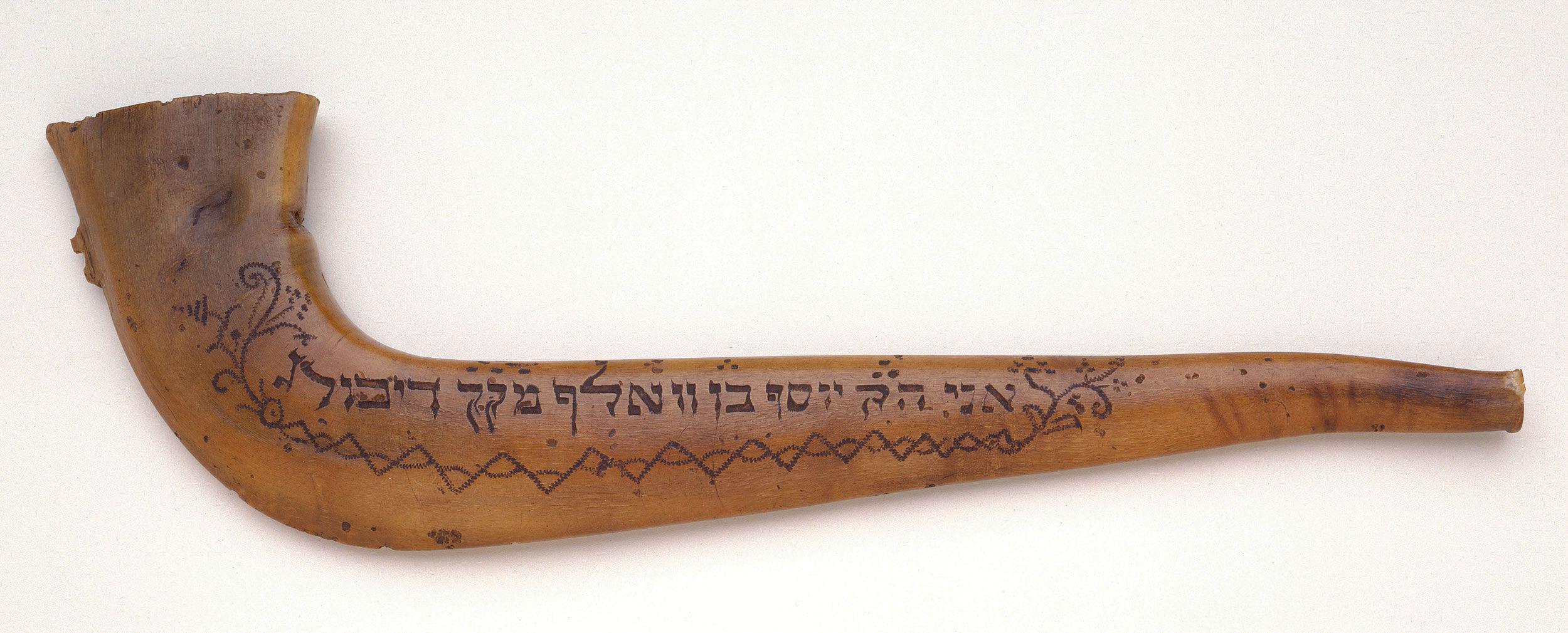
Work
Shofar
Date
Nineteenth or early twentieth century
Artist
Unknown
Place Made
North Africa, Yemen, or India
Medium
Engraved and pierced kudu horn
Credit Line
Gift of Dr. Harry G. Friedman, F 5315

Work
Shofar
Date
Eighteenth century
Artist
Unknown
Place Made
Germany?
Medium
Engraved ram’s horn
Credit Line
Gift of Dr. Harry G. Friedman, F 502
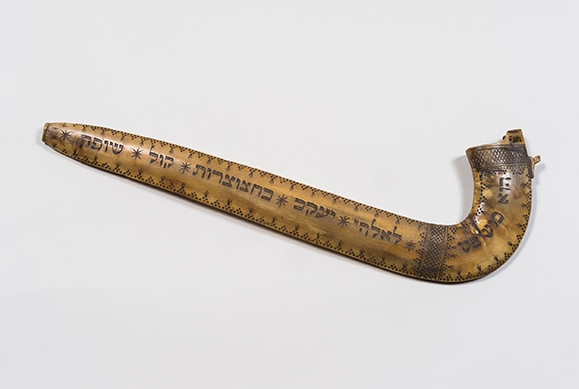
Work
Shofar
Date
Twentieth century?
Artist
Unknown
Place Made
Probably India
Medium
Kudu horn
Credit Line
Gift of the International Synagogue, 2016-22
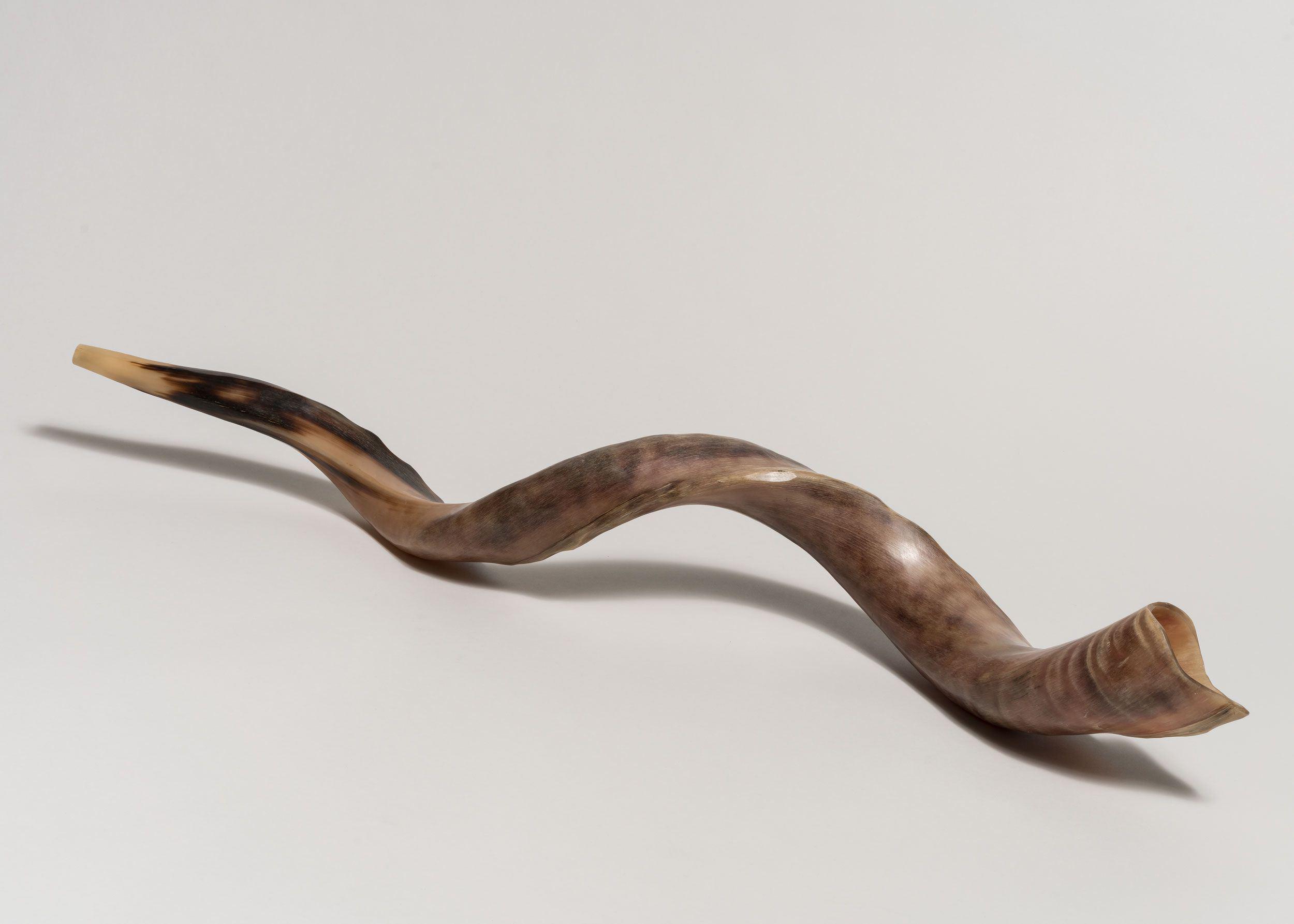
Work
Shofar
Date
Eighteenth or nineteenth century
Artist
Unknown
Place Made
Europe
Medium
Engraved ram’s horn
Credit Line
Gift of the Danzig Jewish Community, D 119

Work
Shofar
Date
Eighteenth or nineteenth century
Artist
Unknown
Place Made
Europe
Medium
Ram’s horn
Credit Line
Gift of Dr. Harry G. Friedman, F 4169
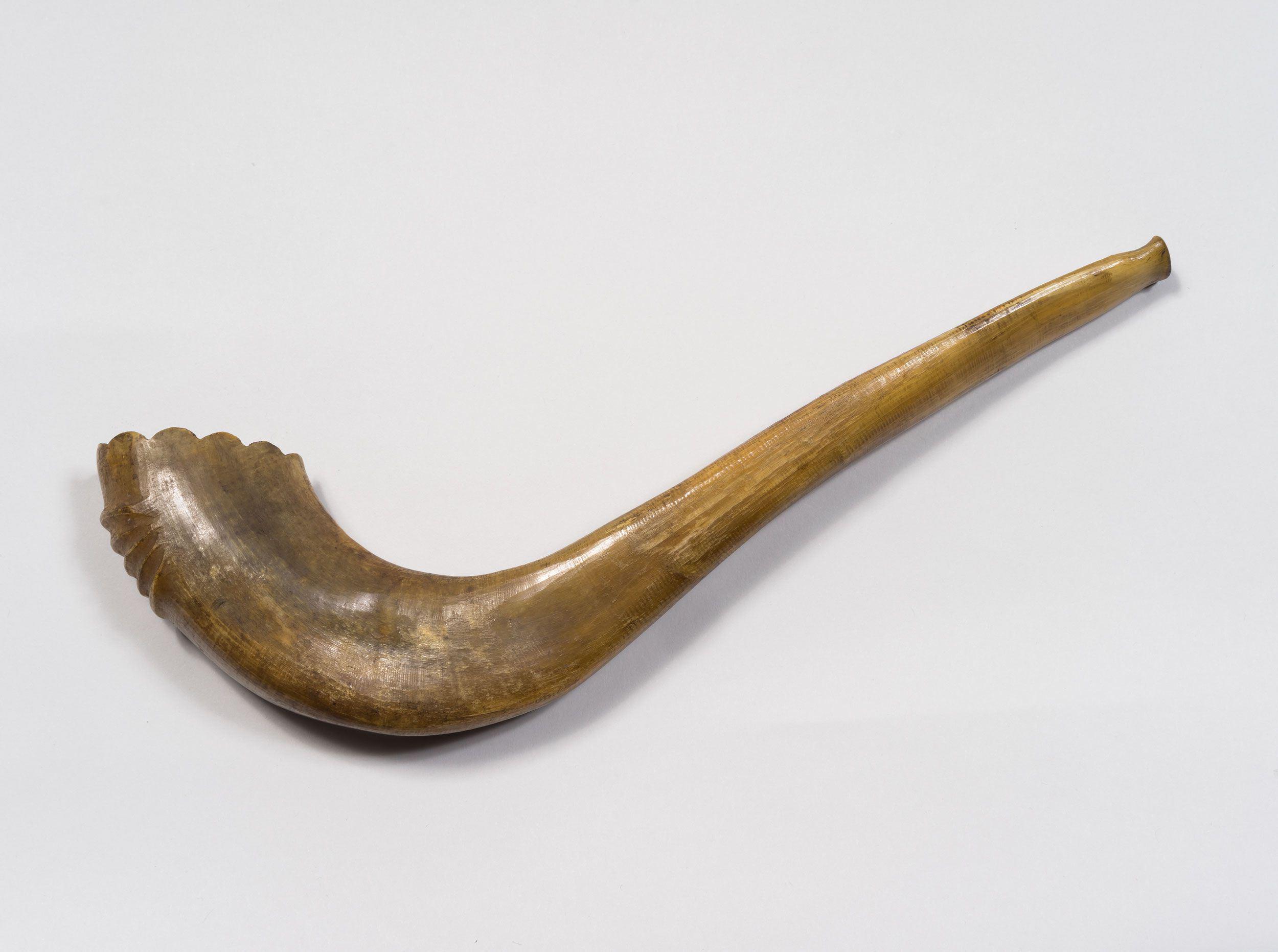
Work
Shofar
Date
Between the nineteenth and mid-twentieth century?
Artist
Unknown
Place Made
Egypt?
Medium
Ram’s horn
Credit Line
Gift of Dr. Harry G. Friedman, F 4978
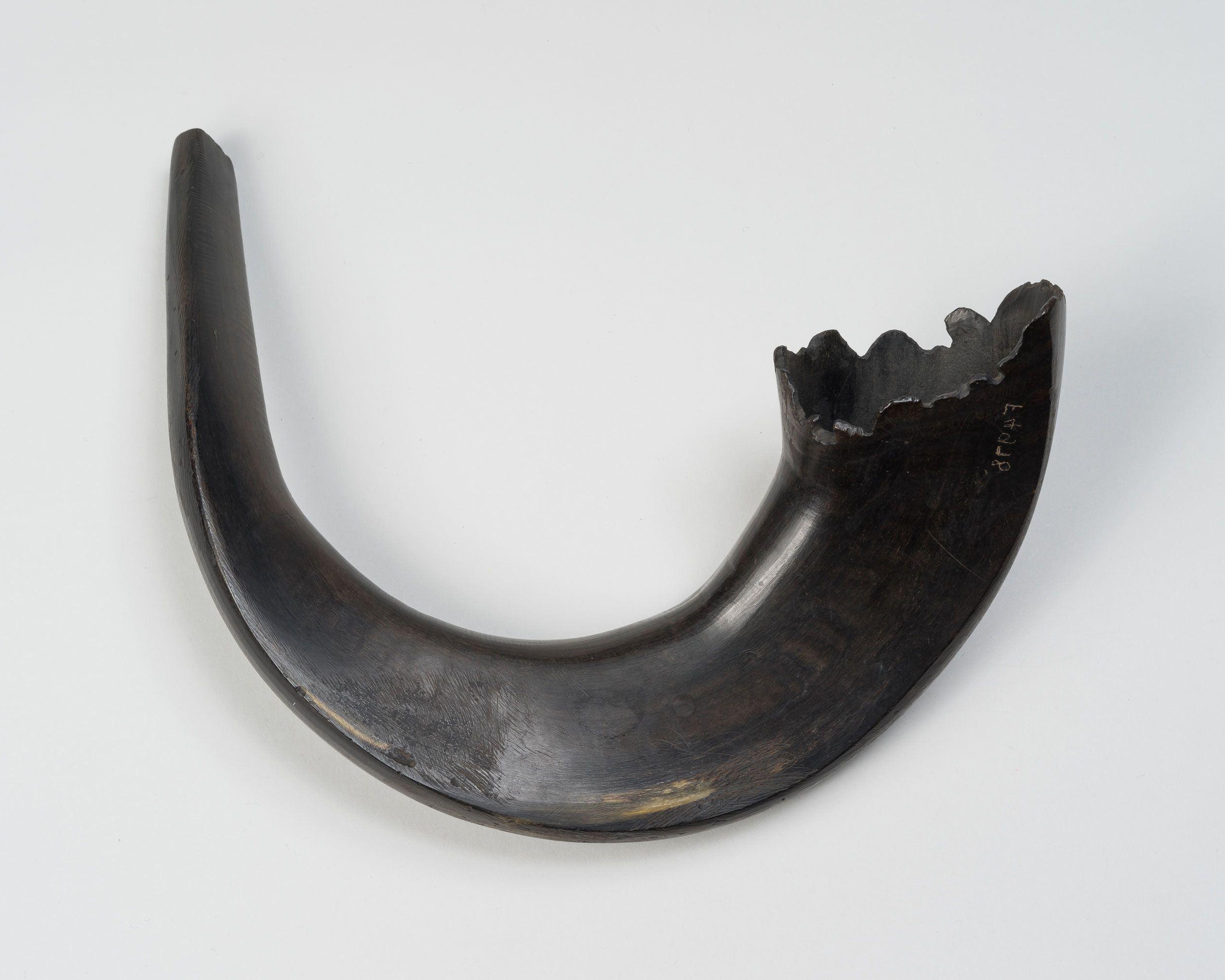
Work
Shofar
Date
Eighteenth or nineteenth century
Artist
Unknown
Place Made
Germany?
Medium
Carved ram’s horn
Credit Line
Gift of the Danzig Jewish Community, D 120
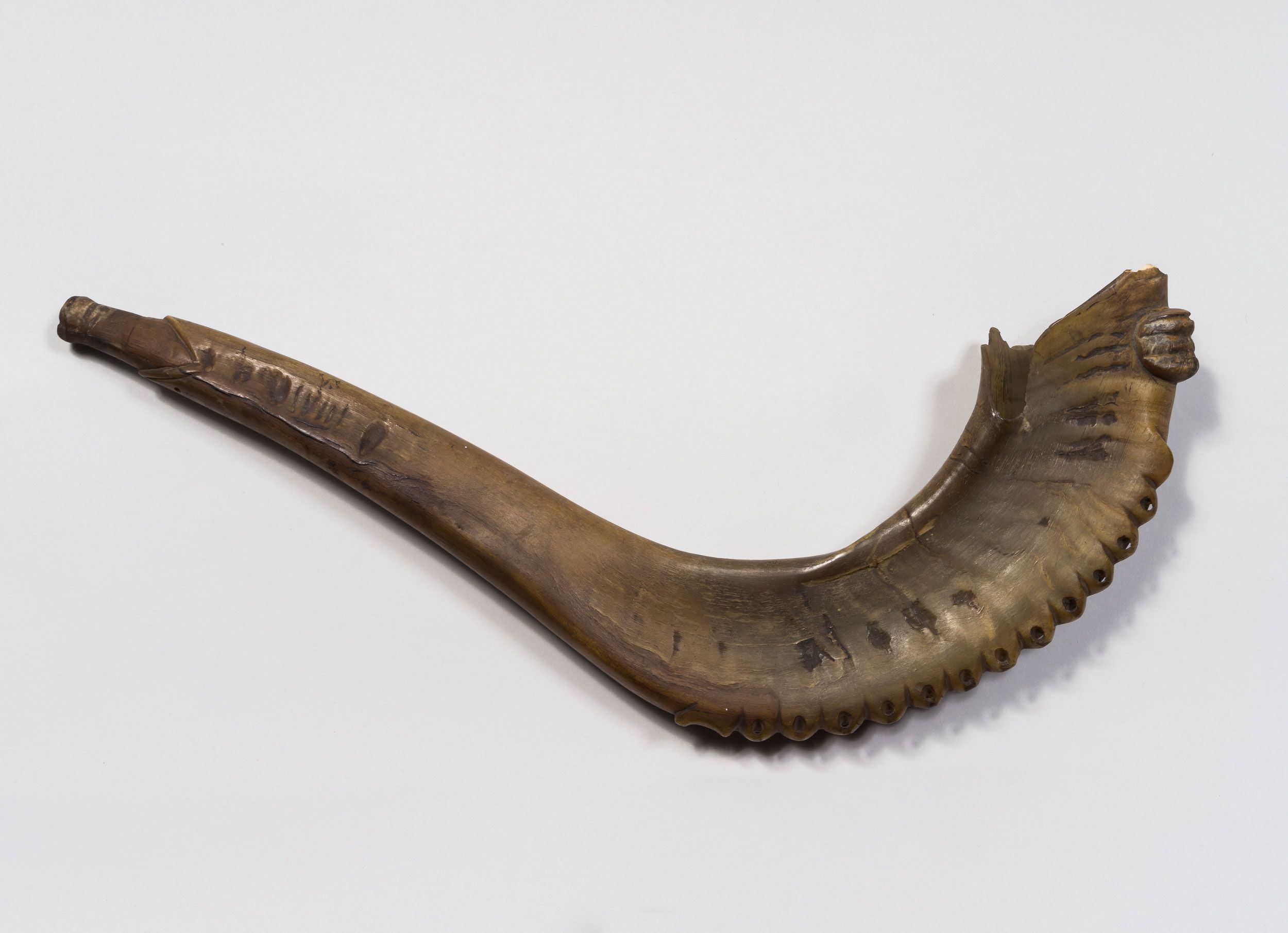
Work
Judaean merchantman ship model
Date
1972, after a wall engraving of the third century CE at Beit She’arim, Israel
Artist
Maker: Yosef Krupnik; designer: M. Pliner
Place Made
Haifa
Medium
Painted wood, cord, and cloth
Credit Line
Gift of Richard Scheuer, JM 13-73
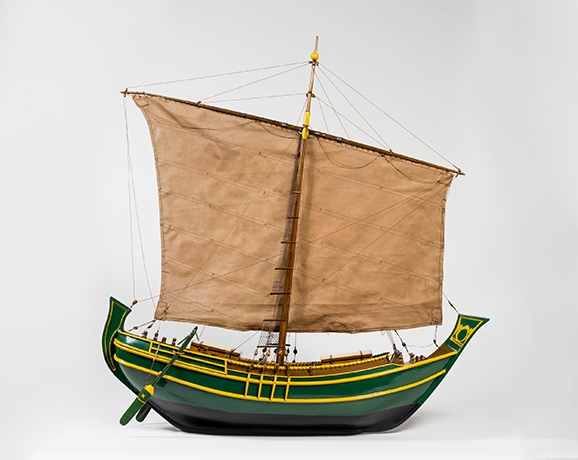
Work
Prayer book cover
Date
1894–95
Artist
Unknown
Place Made
Vienna
Medium
Pierced and engraved silver
Credit Line
Gift of Dr. Harry G. Friedman, F 5129a-b

Work
Prayer book cover
Date
c. 1924
Artist
Unknown, Bezalel School of Arts and Crafts; founded in Jerusalem in 1906
Place Made
Jerusalem
Medium
Acid-etched silver and silver filigree
Credit Line
Gift of Mrs. Henry J. Bernheim, JM 141-47a-b

Work
Prayer book cover
Date
Between 1880 and 1900
Artist
Unknown
Place Made
Vienna?
Medium
Celluloid, bone, and cast and gilded copper alloy
Credit Line
Gift of Dorothy Pearlstein, JM 2-72
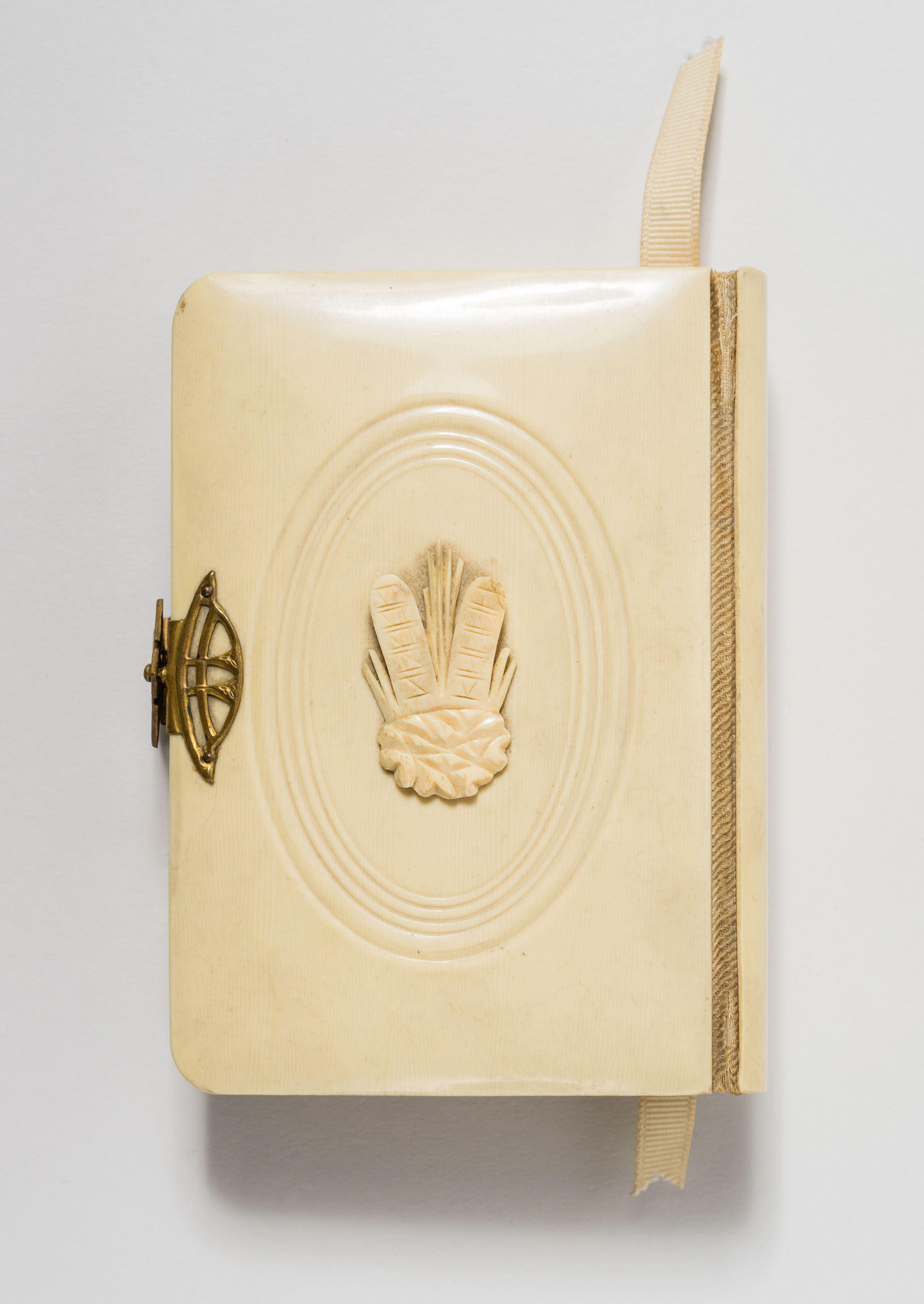
Work
Prayer book cover
Date
1900
Artist
Unknown
Place Made
Vienna
Medium
Bone, cast white metal, copper alloy, velvet, and celluloid
Credit Line
Gift of Dr. Harry G. Friedman, F 4938

Work
Engagement pin
Date
c. 1912
Artist
Unknown
Place Made
Baghdad
Medium
Gold and diamonds
Credit Line
Gift of Helene and David Simon in memory of their mothers, Amouma Simon and Louise Zilkha, 1993-34
This brooch was worn by Amouma Bashi Simon, who lived and married in Baghdad. She received it among other gifts customarily sent by a bridegroom to his fiancée.
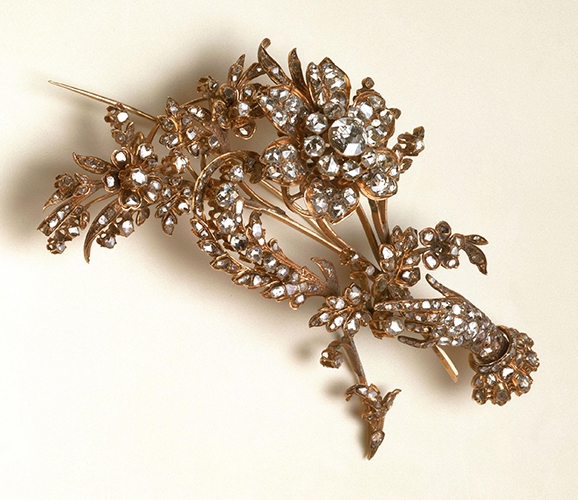
Work
Engagement pin
Date
c. 1912
Artist
Unknown
Place Made
Baghdad
Medium
Gold and diamonds
Credit Line
Gift of Francine and Abdallah Simon in memory of his mother, Amouma Simon, 1993-33
This brooch was worn by Amouma Bashi Simon of Baghdad on her wedding day. She received it among other gifts customarily sent by a bridegroom to his fiancée.

Work
Gates of Freedom Israel Bond sponsor pin
Date
1973
Artist
Chaim Gross; American, born in Austria in 1904, died in 1991
Place Made
United States
Medium
Cast electroplated metal and coral
Credit Line
Gift of the Women’s Division of State of Israel Bonds, 1985-73
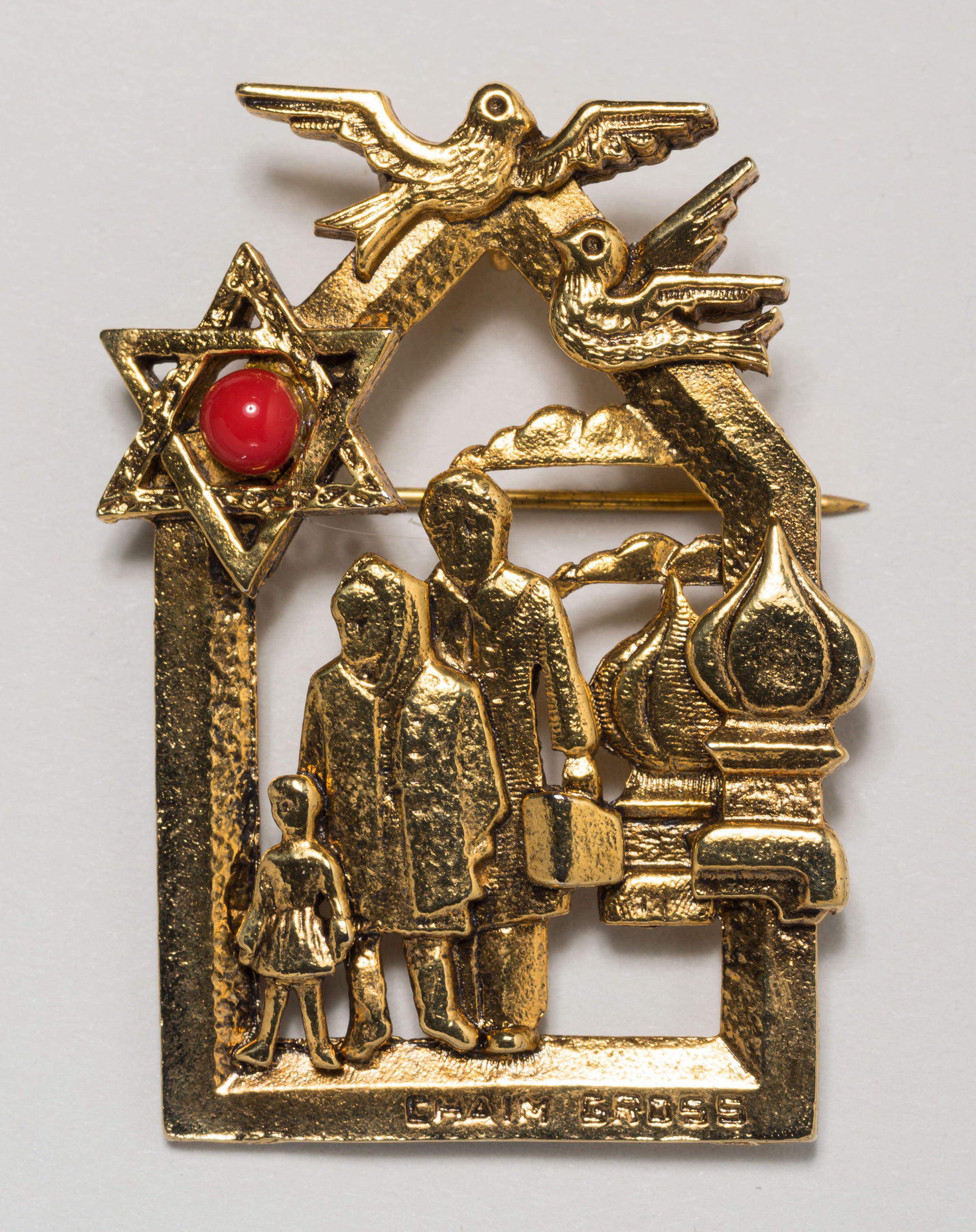
Work
Prayer book cover
Date
Early twentieth century
Artist
Unknown
Place Made
Italy
Medium
Pierced, engraved, repoussé, and cast silver
Credit Line
Gift of Dr. Harry G. Friedman, F 4422a-b

Work
Prayer book cover
Date
1891
Artist
Unknown, stamped with maker’s initials I M
Place Made
Eastern Europe
Medium
Repoussé, chased, and cast silver
Credit Line
Gift of Dr. Henry G. Friedman, F 3286a-b

Work
Prayer book cover
Date
1897
Artist
Unknown
Place Made
Budapest
Medium
Leather and mother-of-pearl
Credit Line
Gift of Mrs. Billie Rubin, 1980-49

Work
Prayer book cover
Date
Eighteenth century
Artist
Unknown
Place Made
Amsterdam
Medium
Tortoiseshell and cast silver
Credit Line
Gift of Pauline Koner and Shaya, 1986-166

Work
Prayer book cover
Date
Second half of the eighteenth century
Artist
Trotro
Place Made
Italy
Medium
Cast, repoussé, and punched silver
Credit Line
Gift of Dr. Harry G. Friedman, F 3070
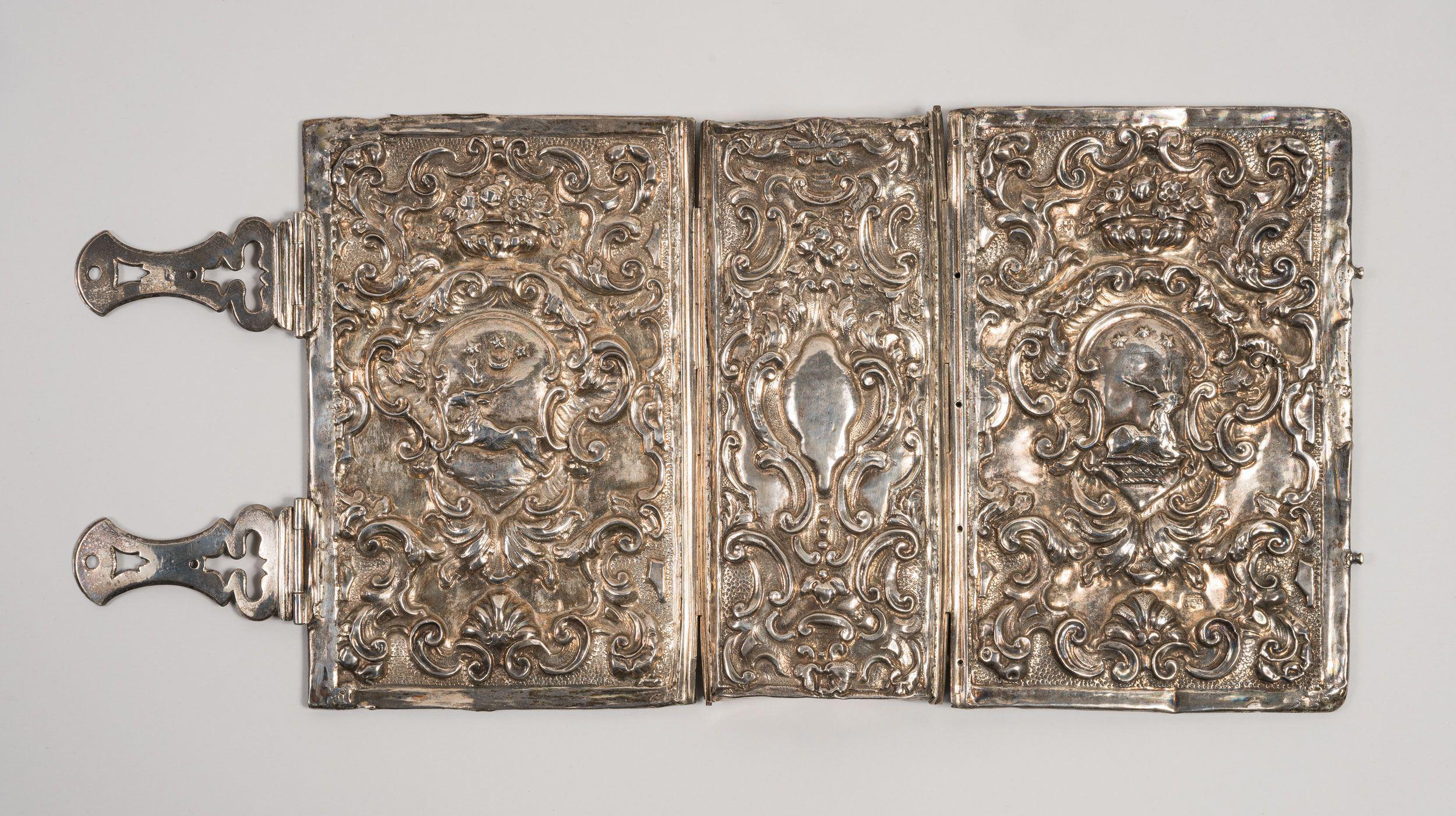
Work
Prayer book cover
Date
First half of the twentieth century
Artist
Unknown
Place Made
Italy
Medium
Pierced, repoussé, traced, engraved, and cast silver
Credit Line
Gift of Dr. Harry G. Friedman, F 2092a-b
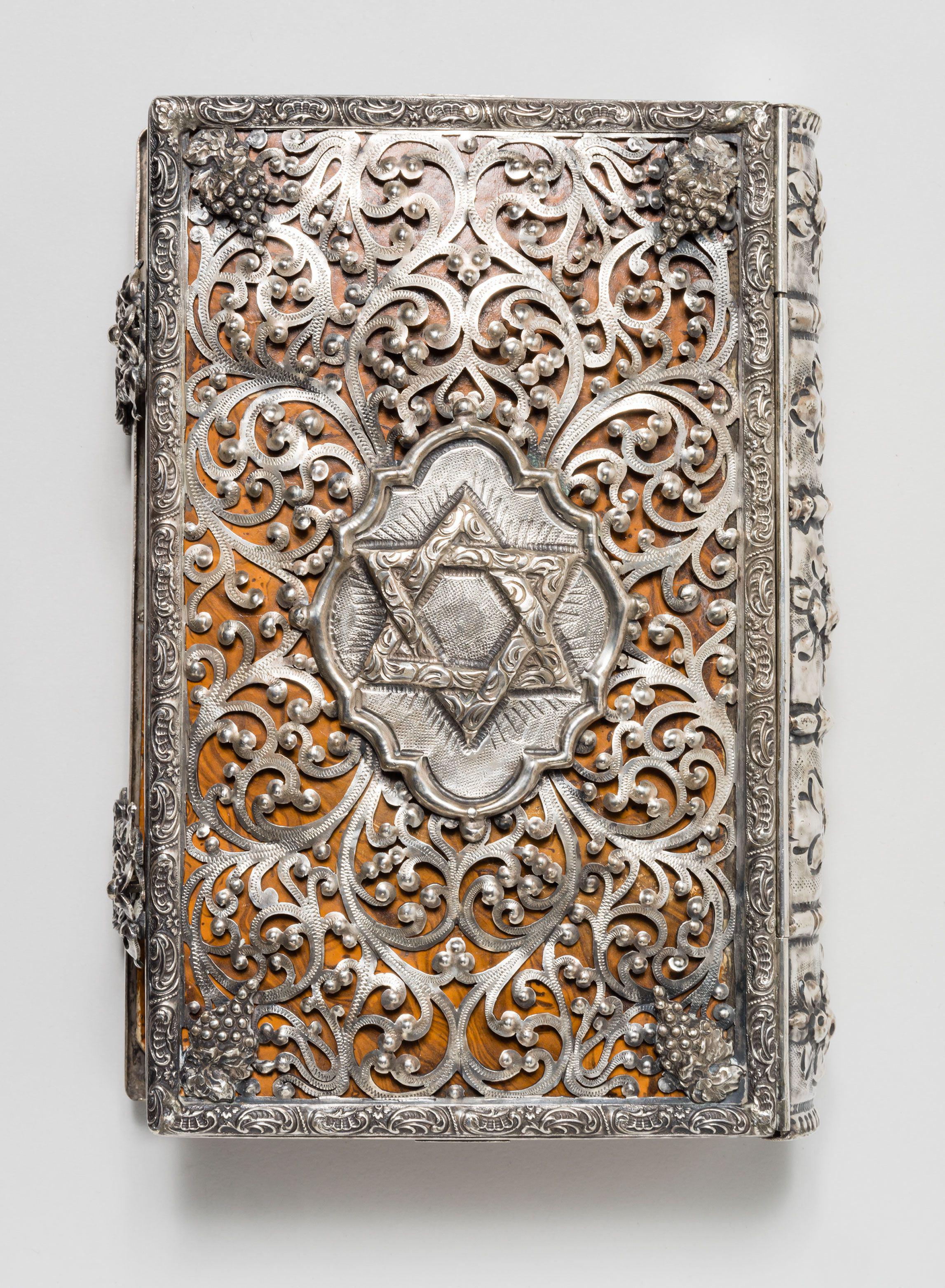
Work
Prayer book cover
Date
Late nineteenth or early twentieth century
Artist
Unknown
Place Made
Germany
Medium
Repoussé silver
Credit Line
Gift of Dr. Harry G. Friedman, F 4982a-b
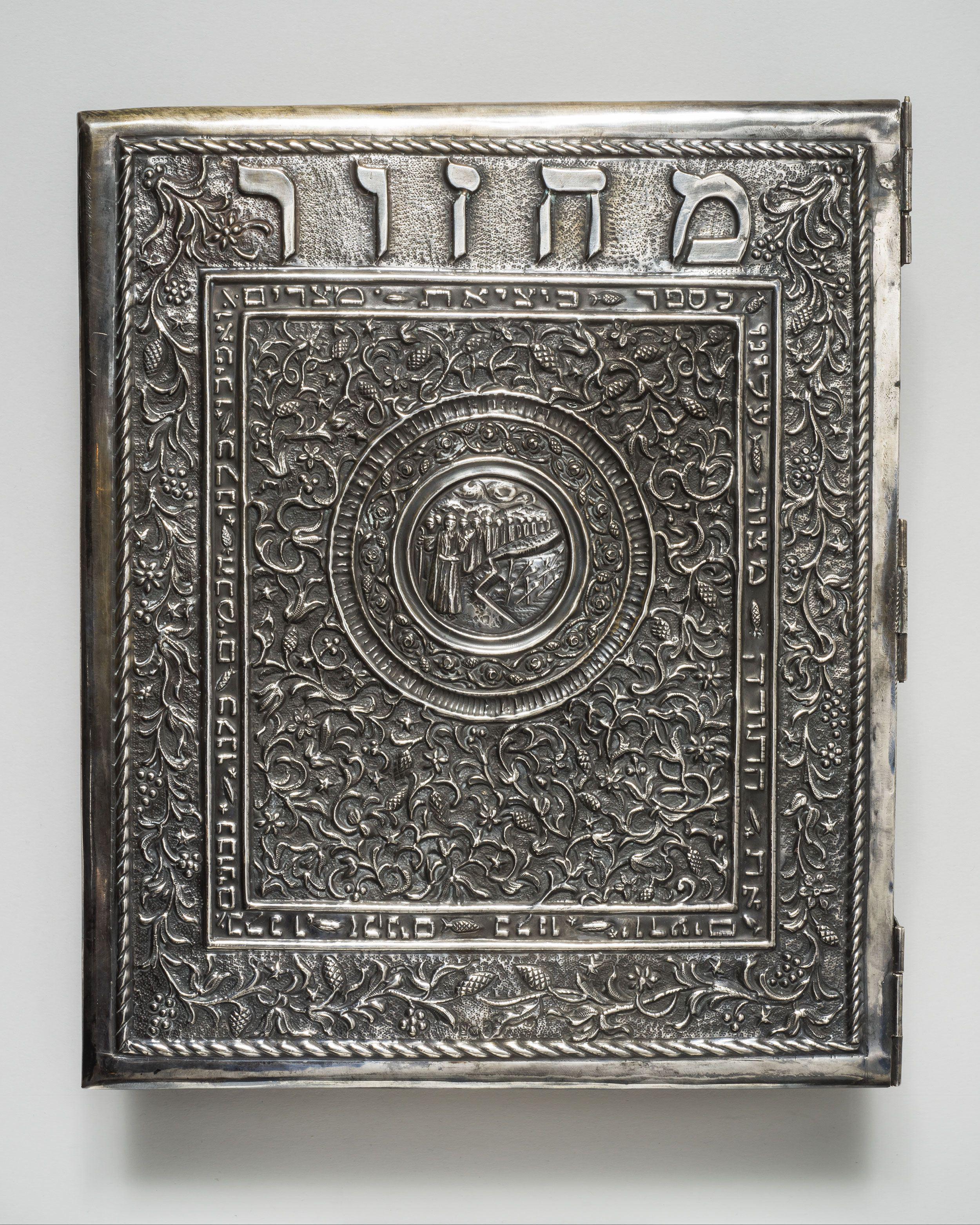
Work
Praying figure
Date
Late nineteenth or early twentieth century
Artist
Unknown
Place Made
United States
Medium
Painted iron
Credit Line
Gift of Sylvia Zenia Rosen Wiener, 2012-28
A spring at the bottom enables this figure to rock back and forth, simulating the traditional motion of Jewish prayer. It may have been inspired by nineteenth-century secular balancing toys and Jewish figures in popular prints. Its purpose is enigmatic—whether it was intended for a Jewish or a non-Jewish audience is unknown.

Work
Prayer book cover
Date
Late eighteenth century
Artist
Unknown
Place Made
Netherlands or Italy
Medium
Repoussé, traced, and punched silver
Credit Line
Gift of Dr. Harry G. Friedman, F 2091a-b
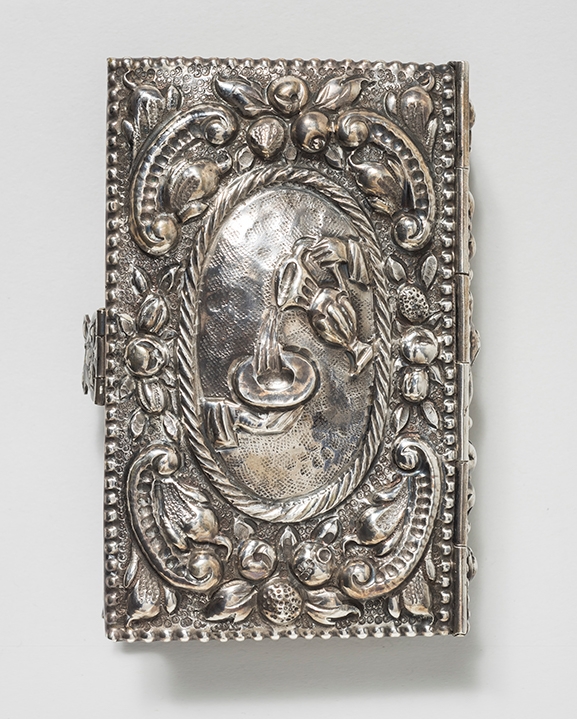
Work
Miniature Hebrew Bible and case
Date
1890s
Artist
Printer: Menahem M. Scholtz
Place Made
Warsaw
Medium
Die-stamped copper alloy, glass, and ink on paper
Credit Line
Gift of Judge Joseph E. Newburger, S 731
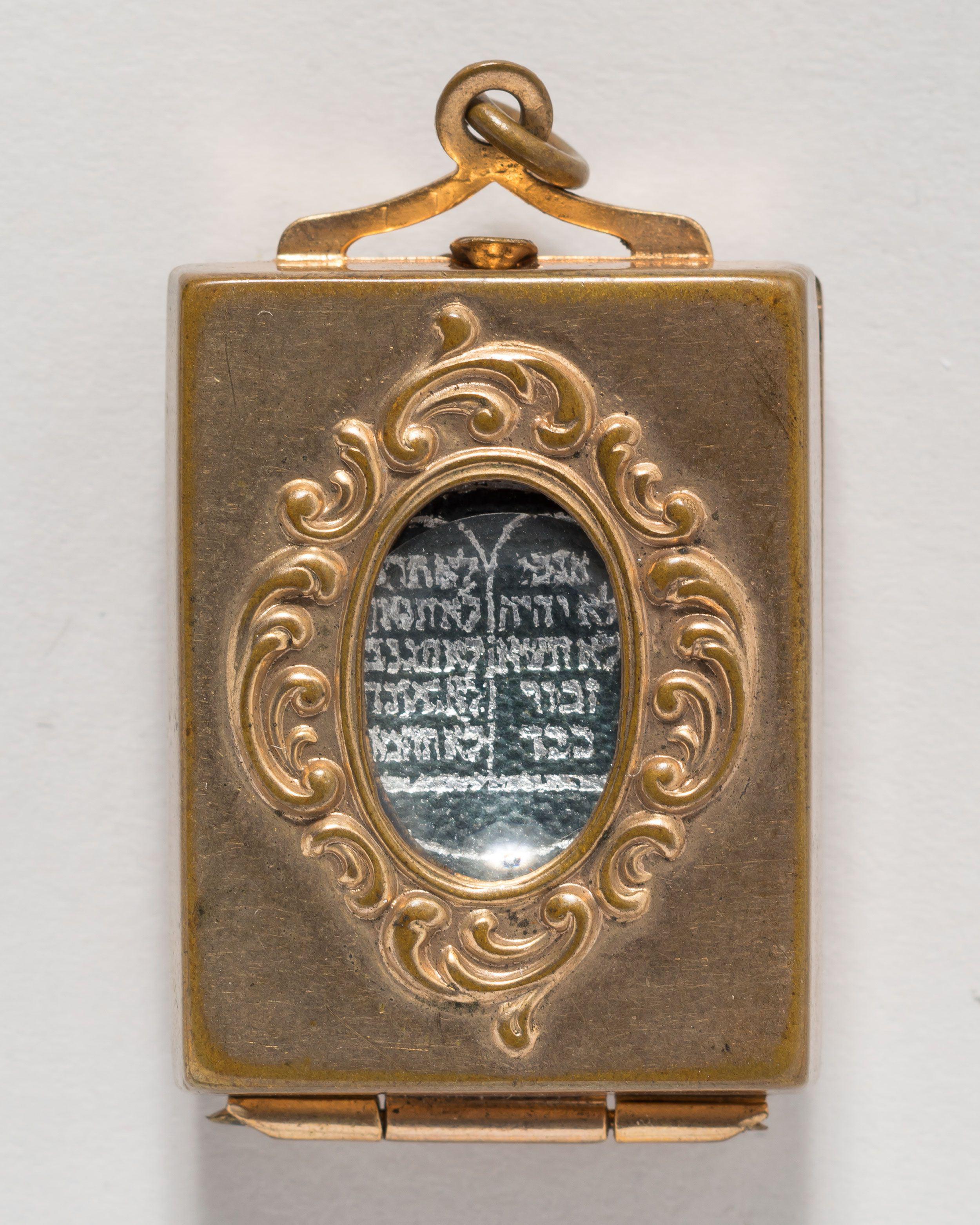
Work
Lamp
Date
Between 2400 and 2000 BCE
Artist
Unknown
Place Made
Israel
Medium
Hand-formed fired clay
Credit Line
Gift of Miriam Schaar Schloessinger, JM 6-61

Work
Lamp
Date
Between 800 and 700 BCE
Artist
Unknown
Place Made
Israel
Medium
Wheel-formed fired clay
Credit Line
Purchase: Archaeology Acquisition Fund, JM 12-73.49
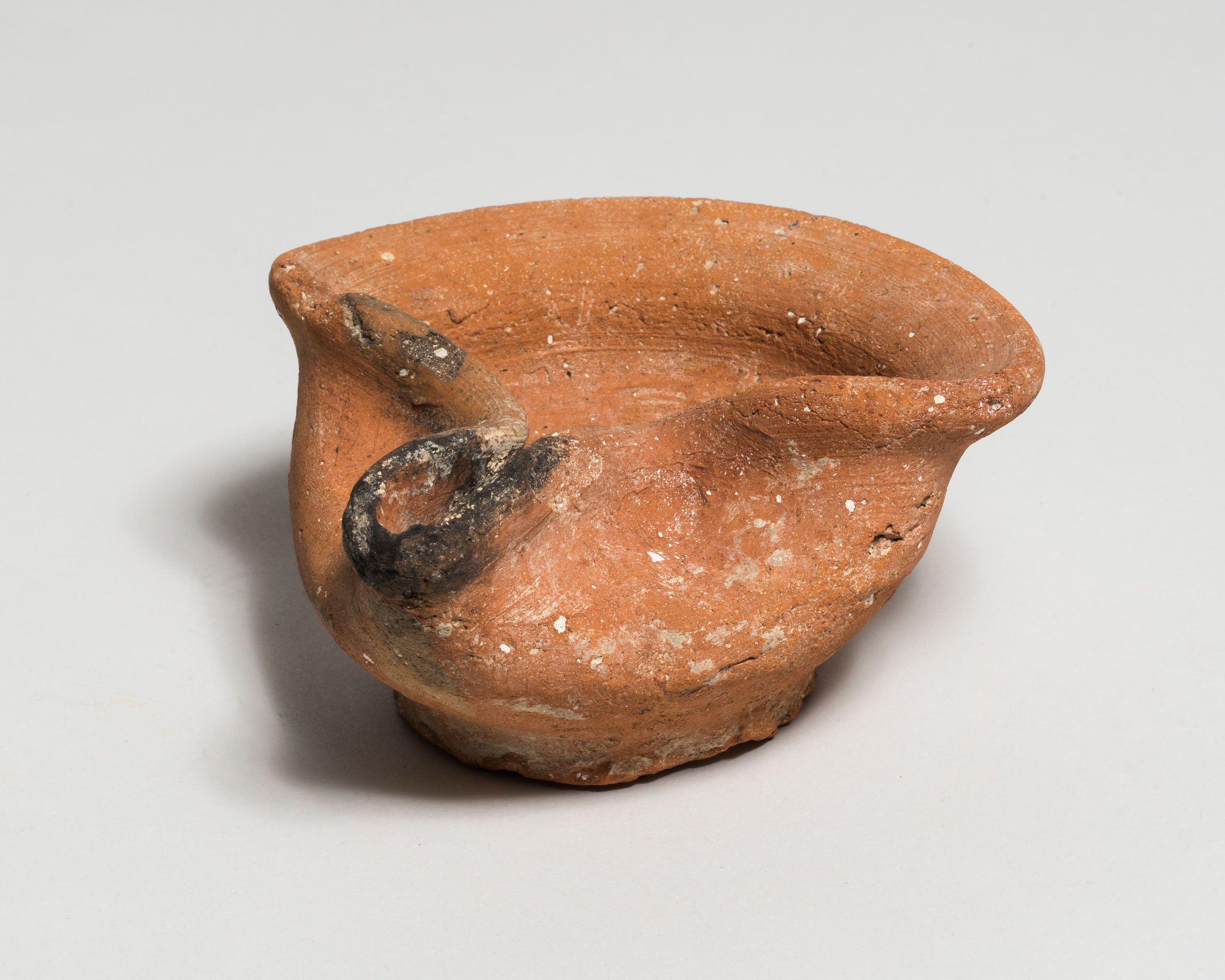
Work
Female votive head
Date
Early fifth century BCE
Artist
Unknown
Place Made
Cyprus?
Medium
Carved and painted limestone
Credit Line
Gift of the Betty and Max Ratner Collection, 1981-129
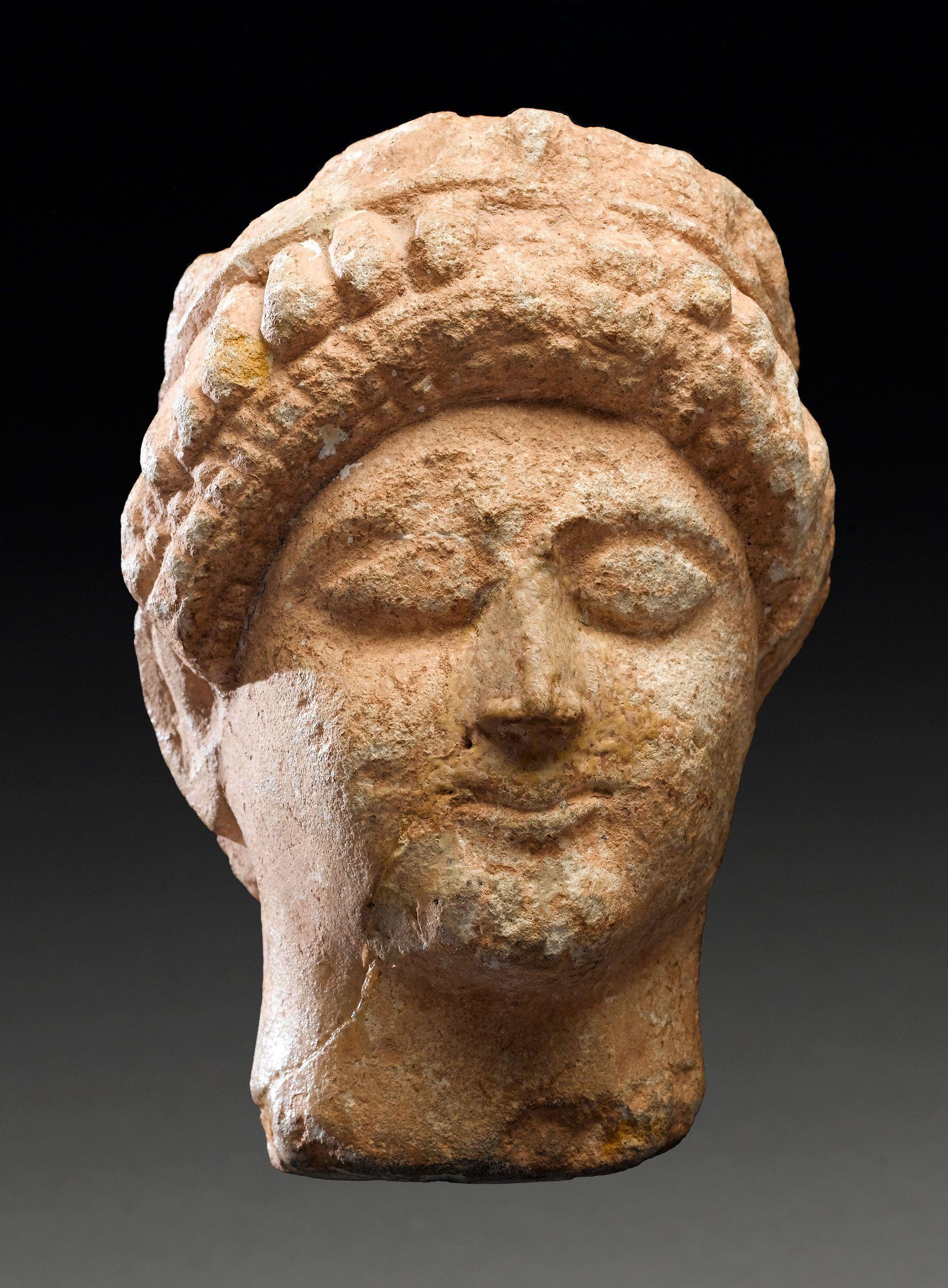
Work
Bull figurine
Date
Between 2000 and 1750 BCE
Artist
Unknown
Place Made
Syria
Medium
Hand-formed, pierced, slipped, and fired clay
Credit Line
Gift of the Betty and Max Ratner Collection, 1981-156
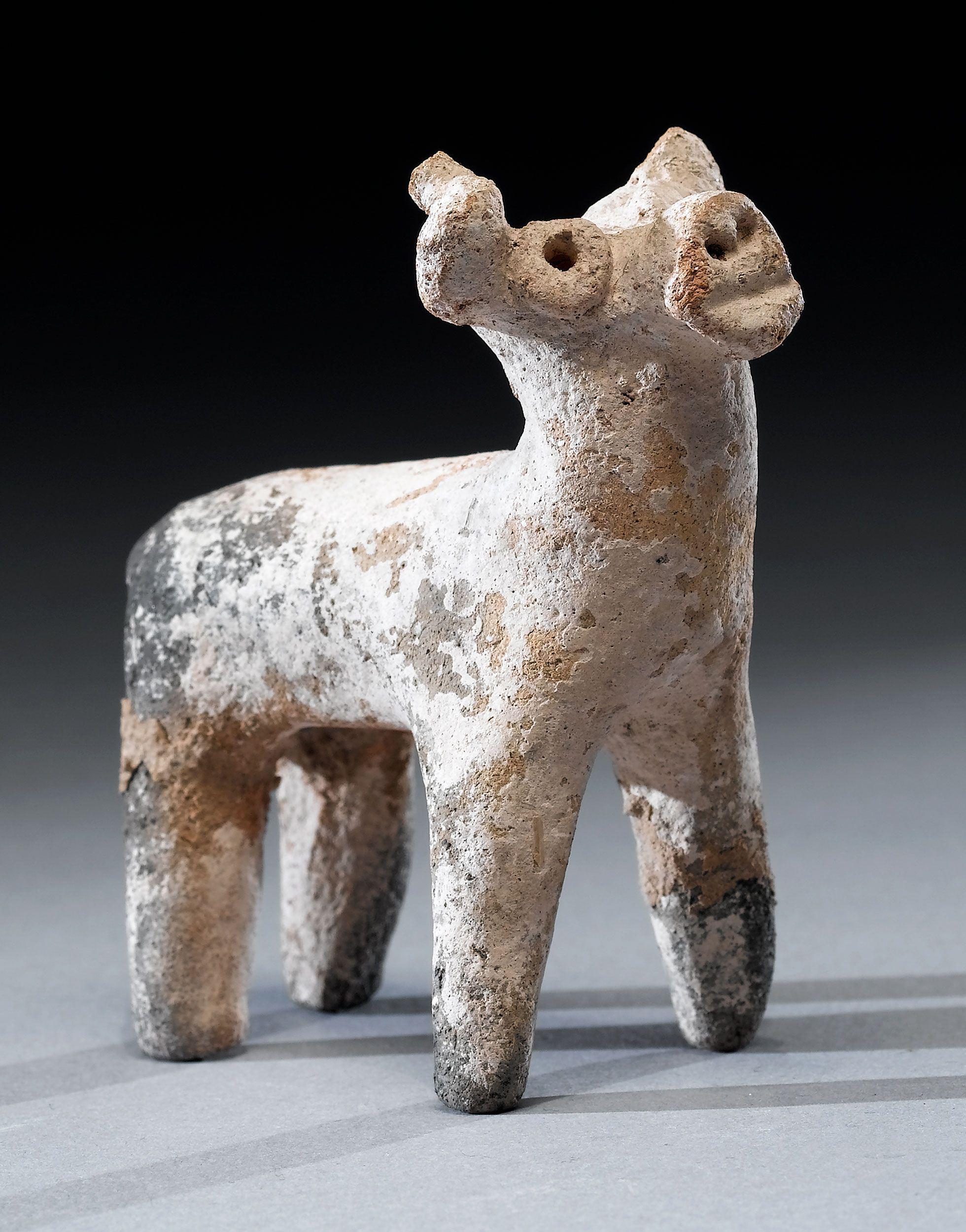
Work
Lamp
Date
Between the second and first century BCE
Artist
Unknown
Place Made
Israel
Medium
Wheel-turned, folded, and fired clay
Credit Line
Gift of the Betty and Max Ratner Collection, 1981-134
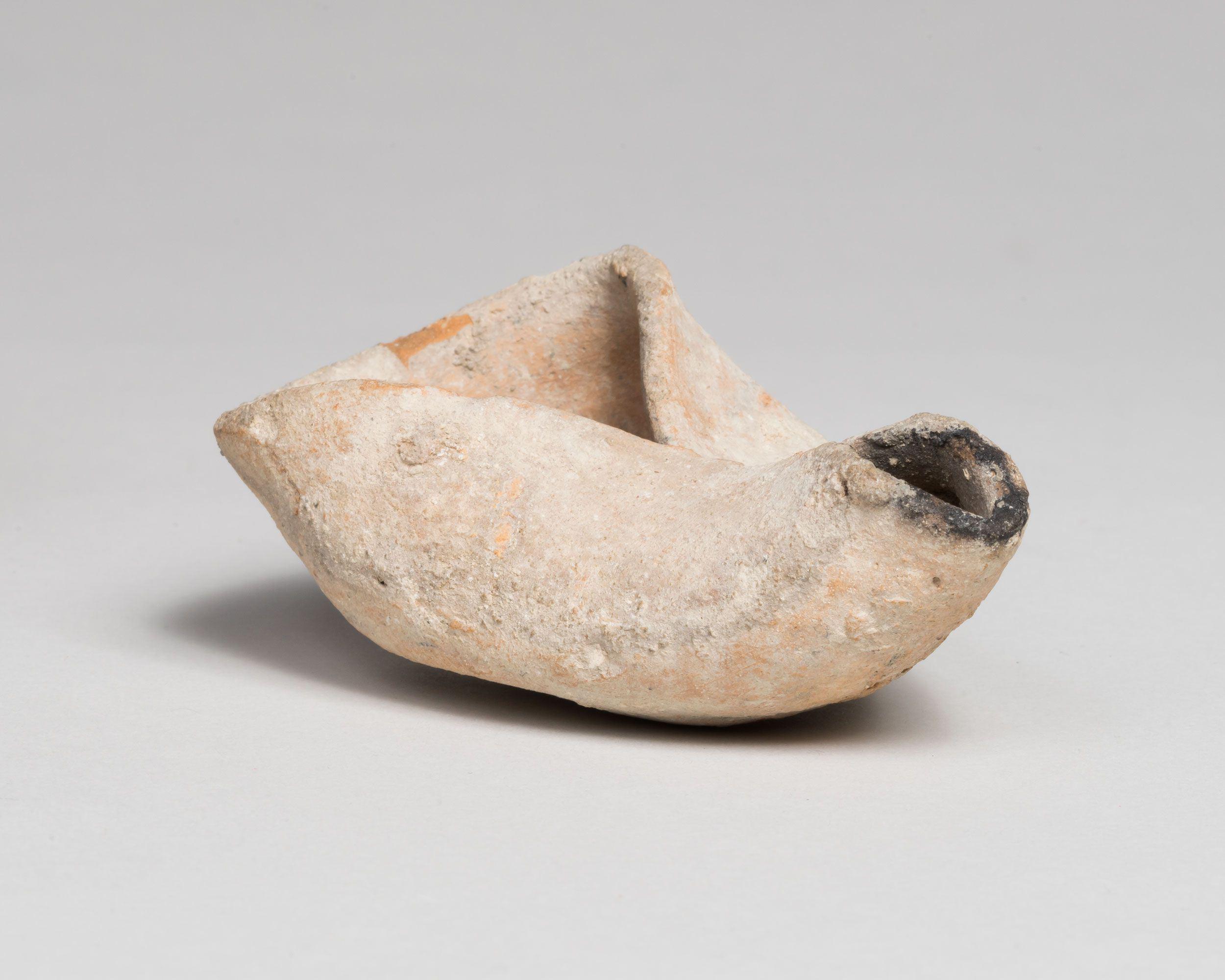
Work
Lamp
Date
First or second century CE
Artist
Unknown
Place Made
Probably Israel
Medium
Wheel-turned, slipped, and fired clay
Credit Line
T 11
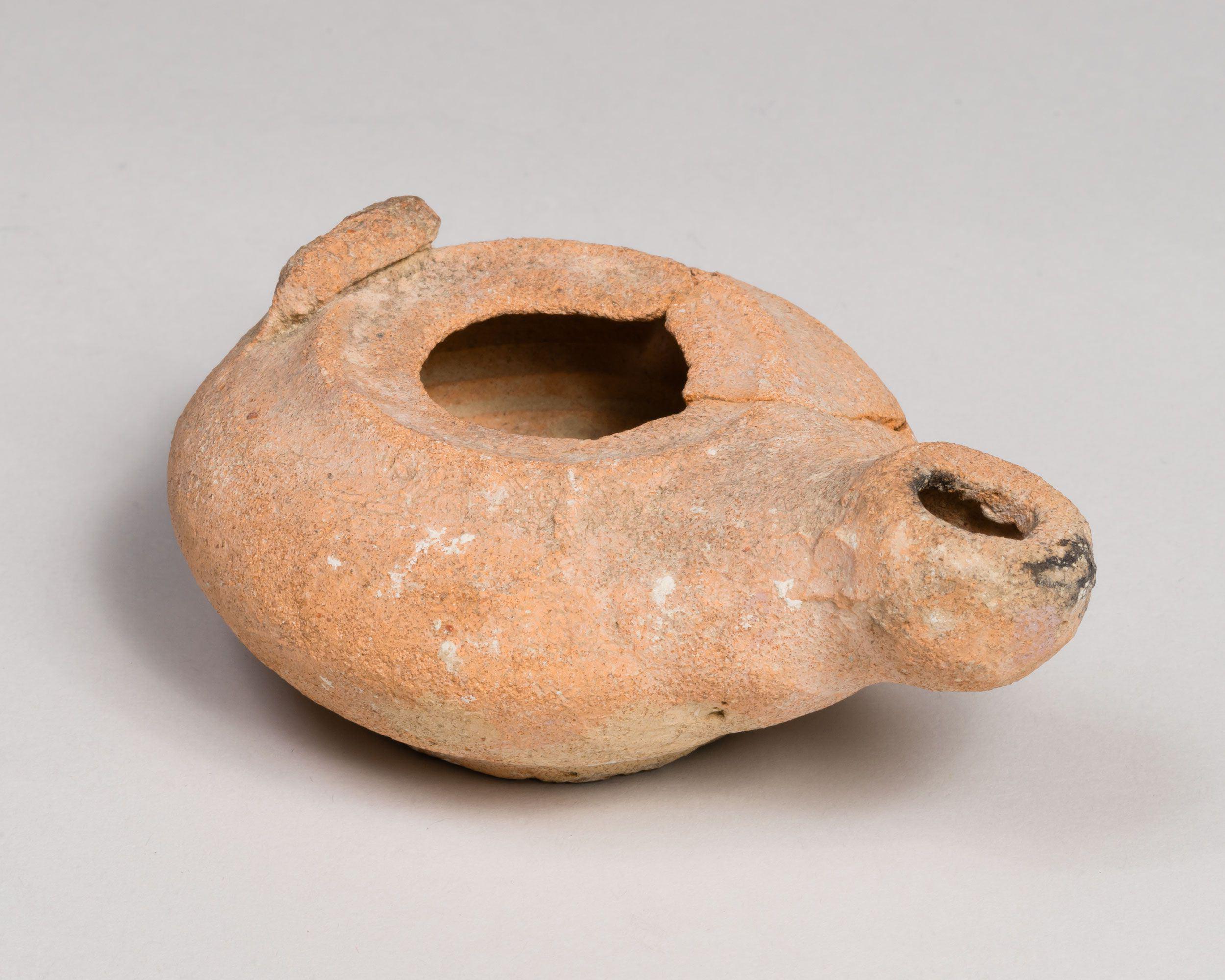
Work
Oil lamp with an image of gladiators
Date
Fourth century CE
Artist
Unknown
Place Made
Italy
Medium
Mold-formed, slipped, and fired clay
Credit Line
Gift of the Betty and Max Ratner Collection, 1981-91
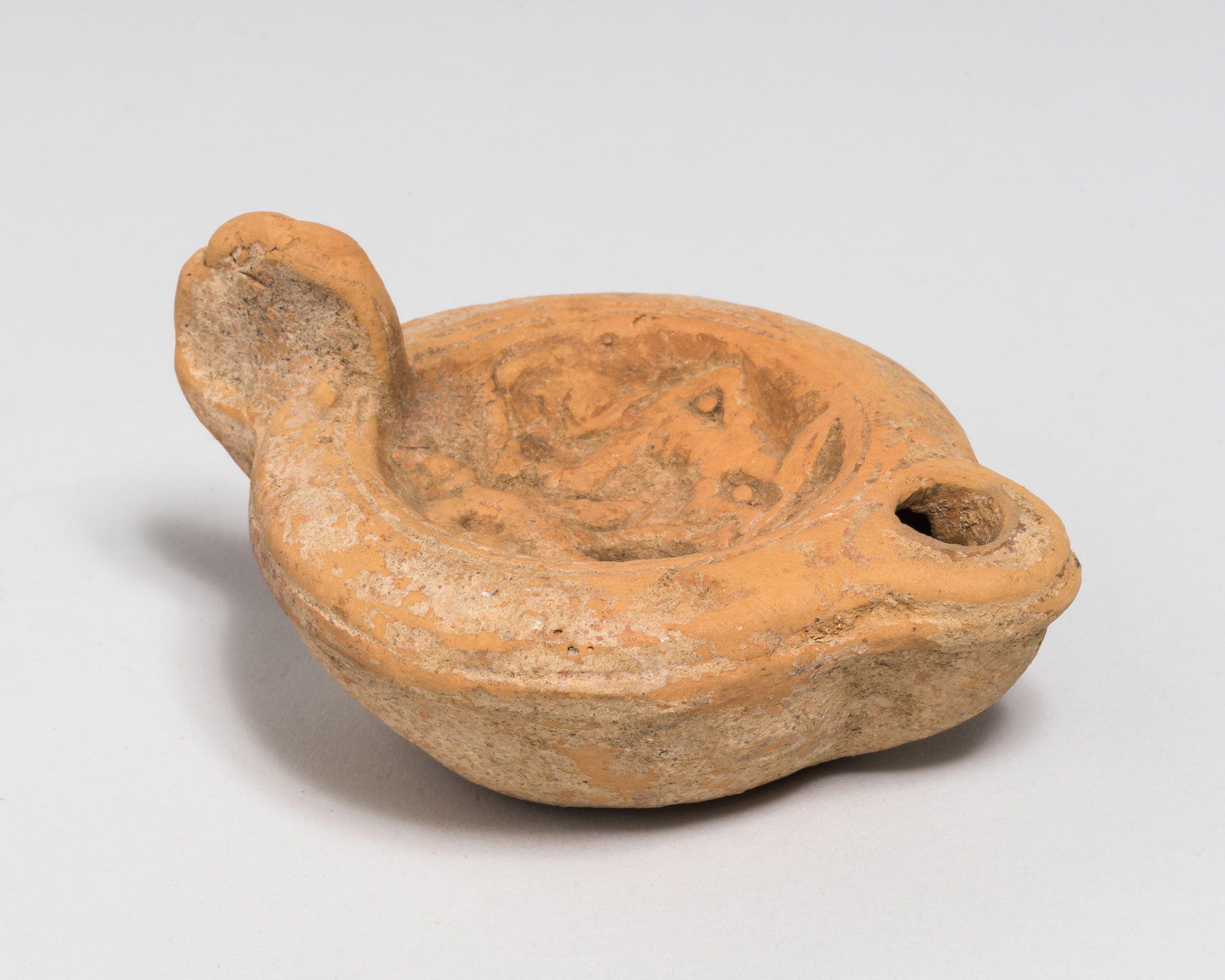
Work
Clock and music box
Date
Early twentieth century
Artist
Possibly Alfred Hamburger
Place Made
Vienna
Medium
Cast and silver-plated copper alloy, velvet, and glass
Credit Line
Gift of Cyrily Abel Weinstein in memory of her father Simon Abels, JM 10-51
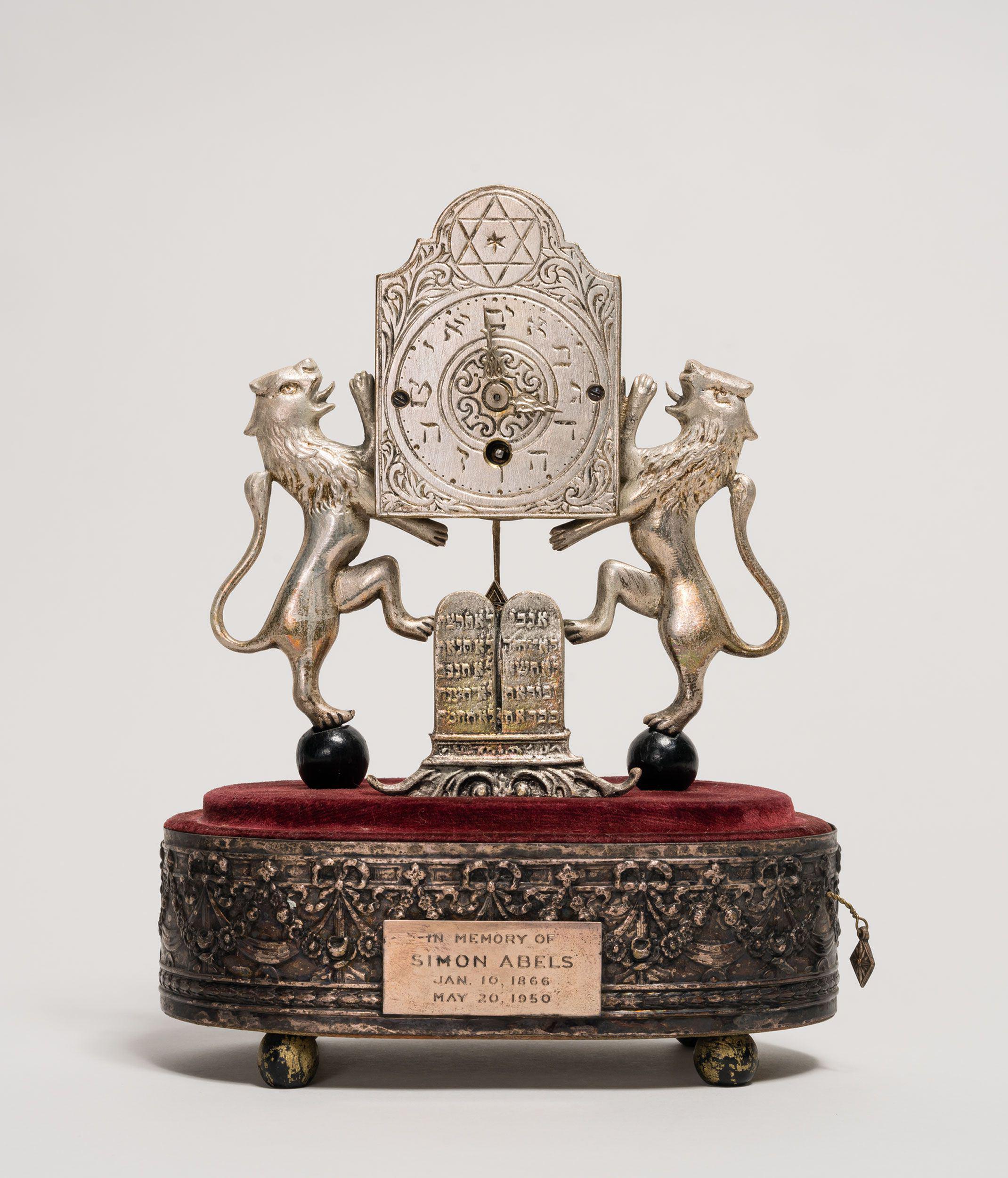
Work
Clock
Date
Late nineteenth or early twentieth century
Artist
Unknown
Place Made
Europe?
Medium
Cast and parcel-gilt copper alloy
Credit Line
Gift of the Children of Samuel Wilner, S 869
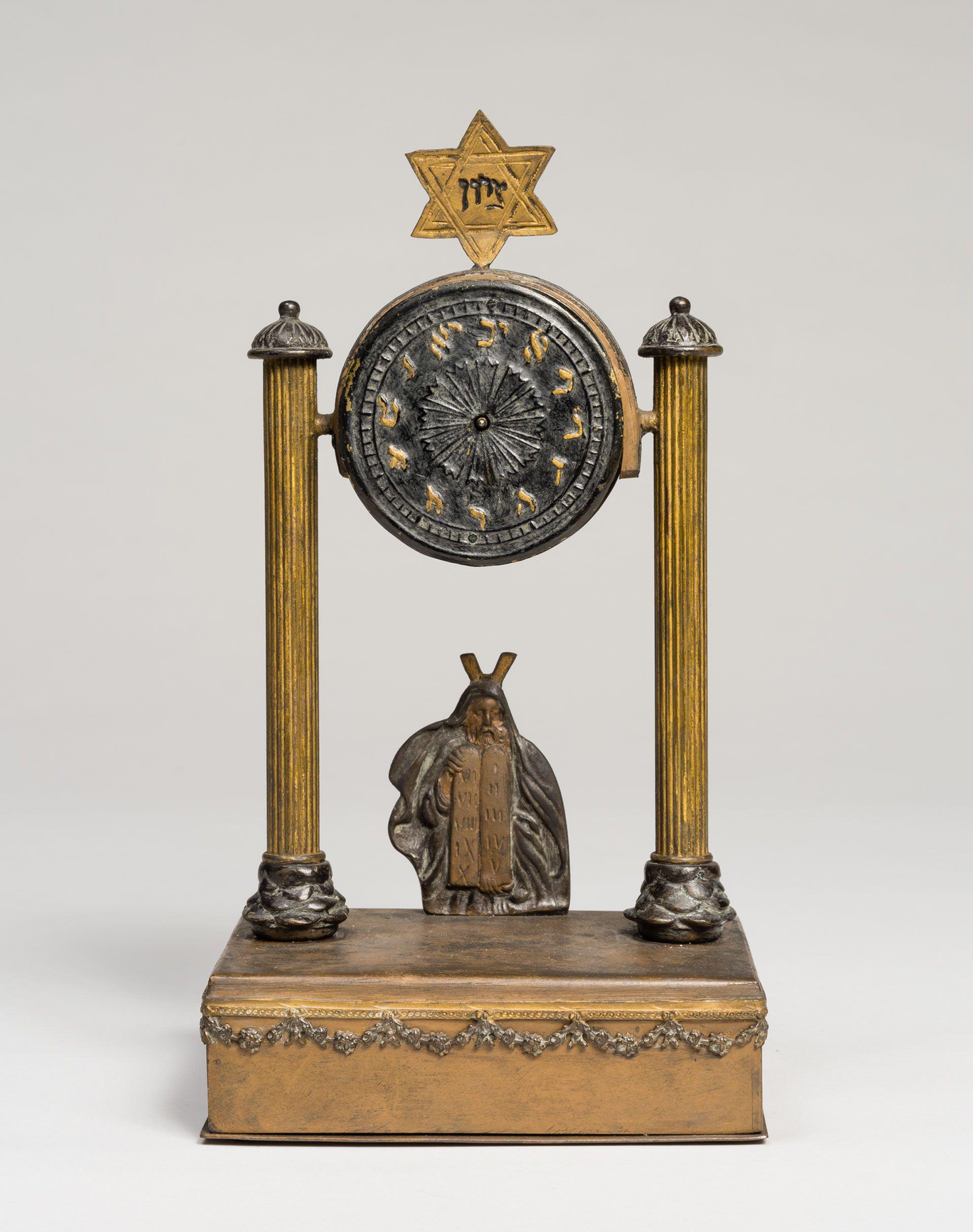
Work
Clock
Date
End of the nineteenth or early twentieth century
Artist
Jacob Striscner
Place Made
Europe
Medium
Cast and chased copper alloy
Credit Line
S 1452

Work
Clock
Date
Nineteenth century?
Artist
Unknown
Place Made
Europe
Medium
Cast silver and enamel
Credit Line
Gift of Dr. Harry G. Friedman, F 2825

Work
Cup
Date
First century CE
Artist
Unknown
Place Made
Eastern Mediterranean
Medium
Free-blown, hand-tooled, and wheel-ground glass
Credit Line
Museum purchase, S 1205
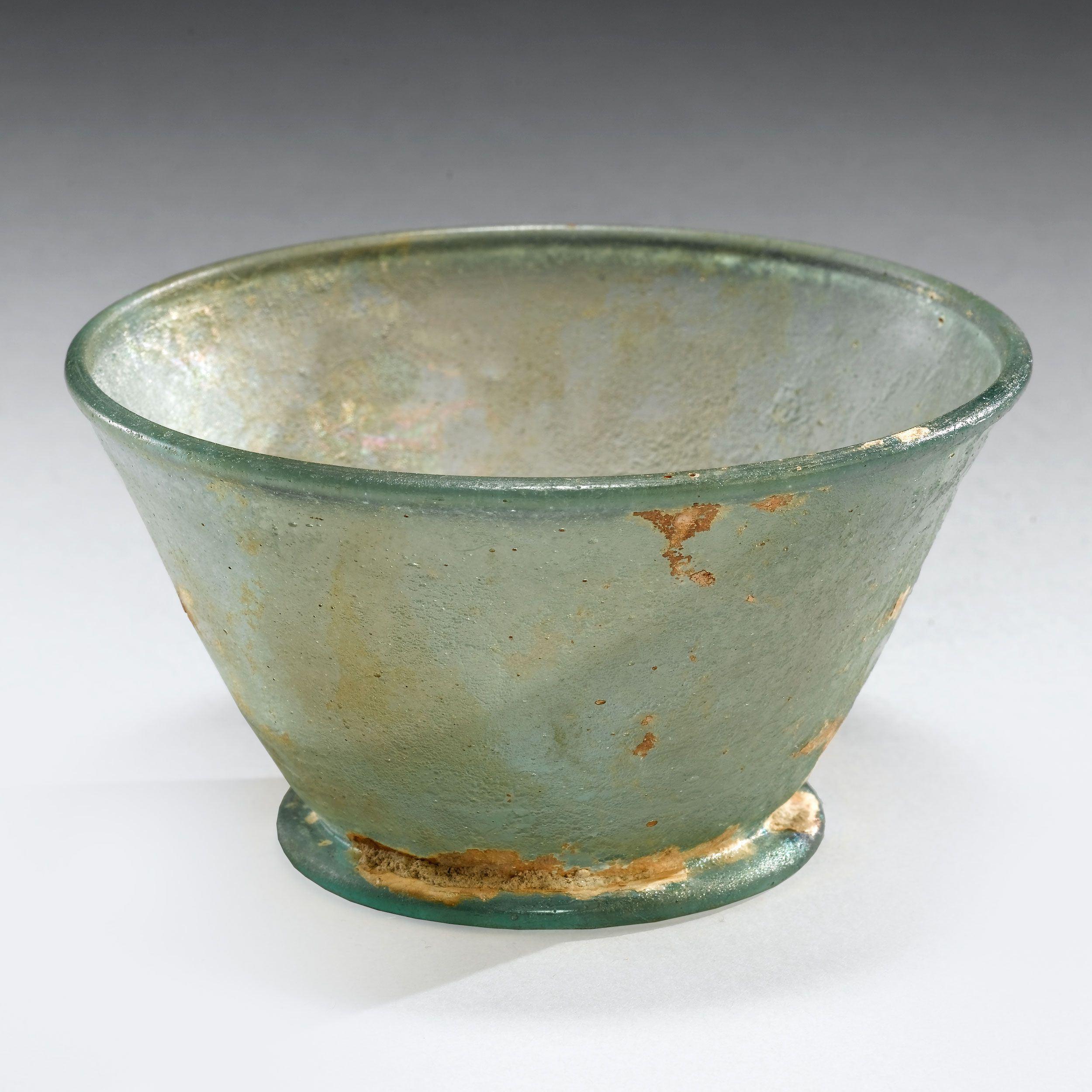
Work
Goblet
Date
Fifth or sixth century CE
Artist
Unknown
Place Made
Eastern Mediterranean
Medium
Free-blown and tooled glass
Credit Line
Gift of Elaine and Harvey Rothenberg, JM 114-79
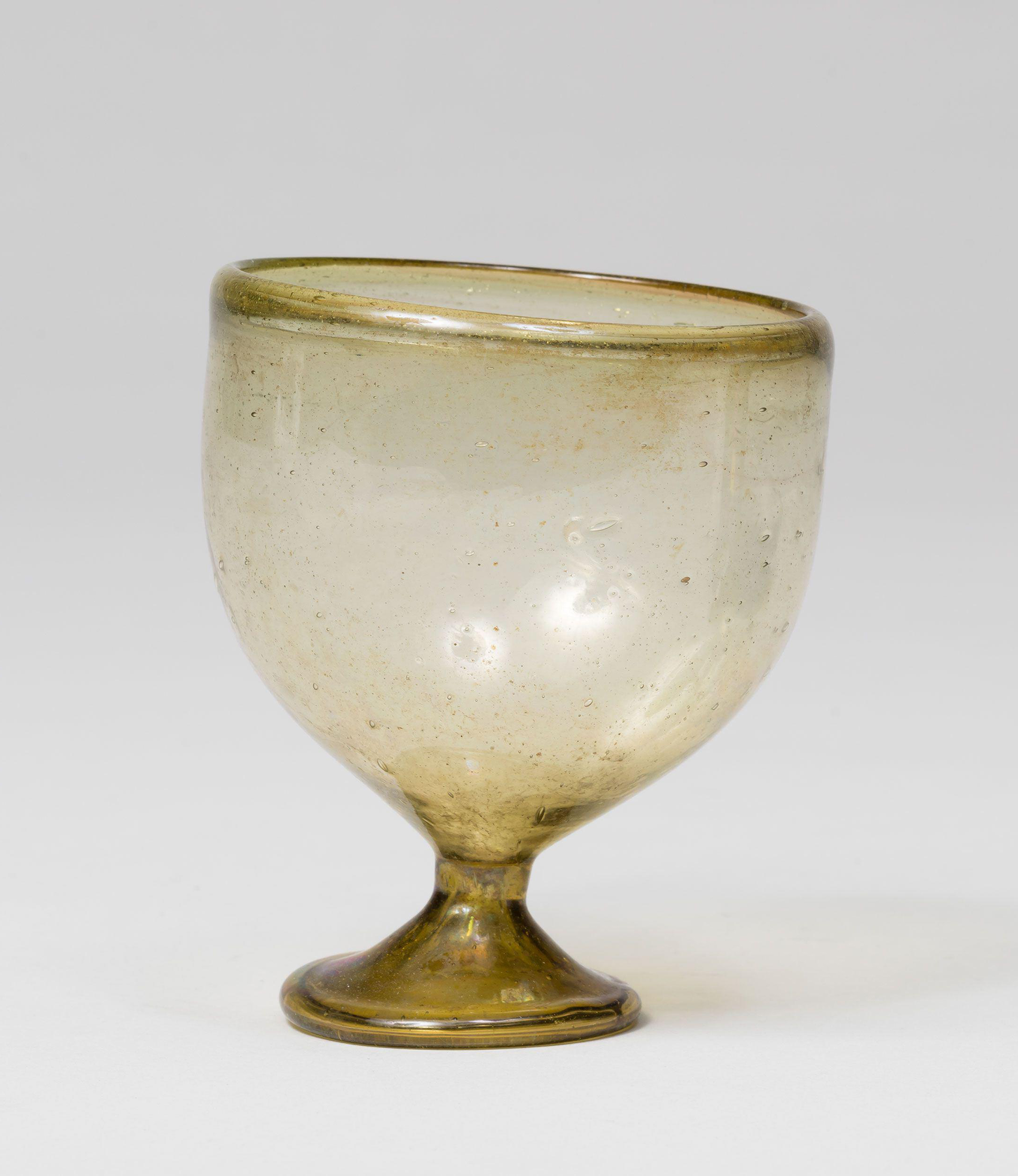
Work
Amphoriskos
Date
First century CE
Artist
Unknown
Place Made
Eastern Mediterranean
Medium
Free-blown and hand-tooled glass
Credit Line
Gift of Elaine and Harvey Rothenberg, JM 116-79
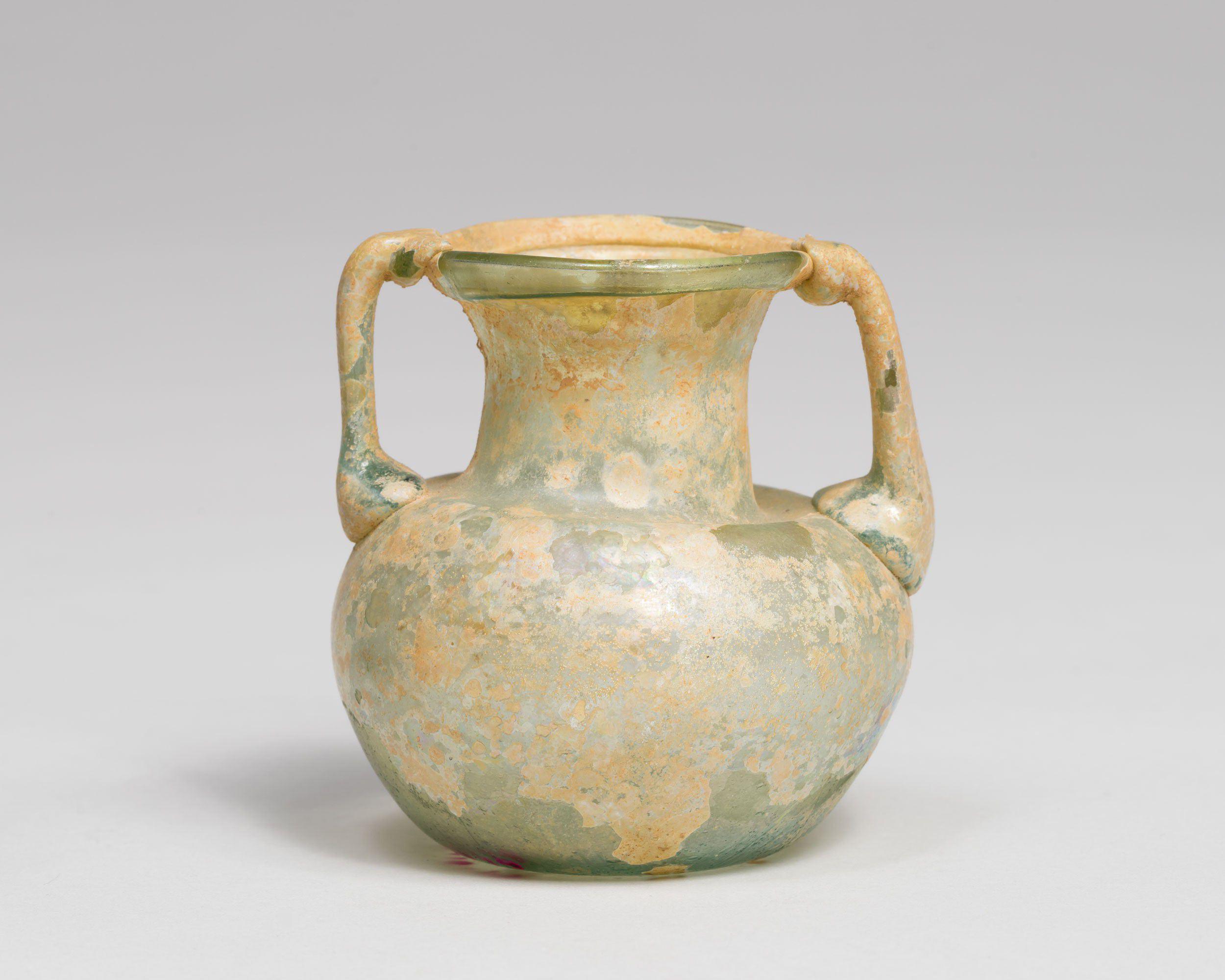
Work
Jar
Date
Second century CE
Artist
Unknown
Place Made
Eastern Mediterranean
Medium
Free-blown, tooled, wheel-ground, and polished glass
Credit Line
Gift of Elaine and Harvey Rothenberg, JM 115-79

Work
Dropper flask
Date
Third or fourth century CE
Artist
Unknown
Place Made
Eastern Mediterranean
Medium
Free-blown and tooled glass
Credit Line
Gift of Theresa Goell, JM 29-55
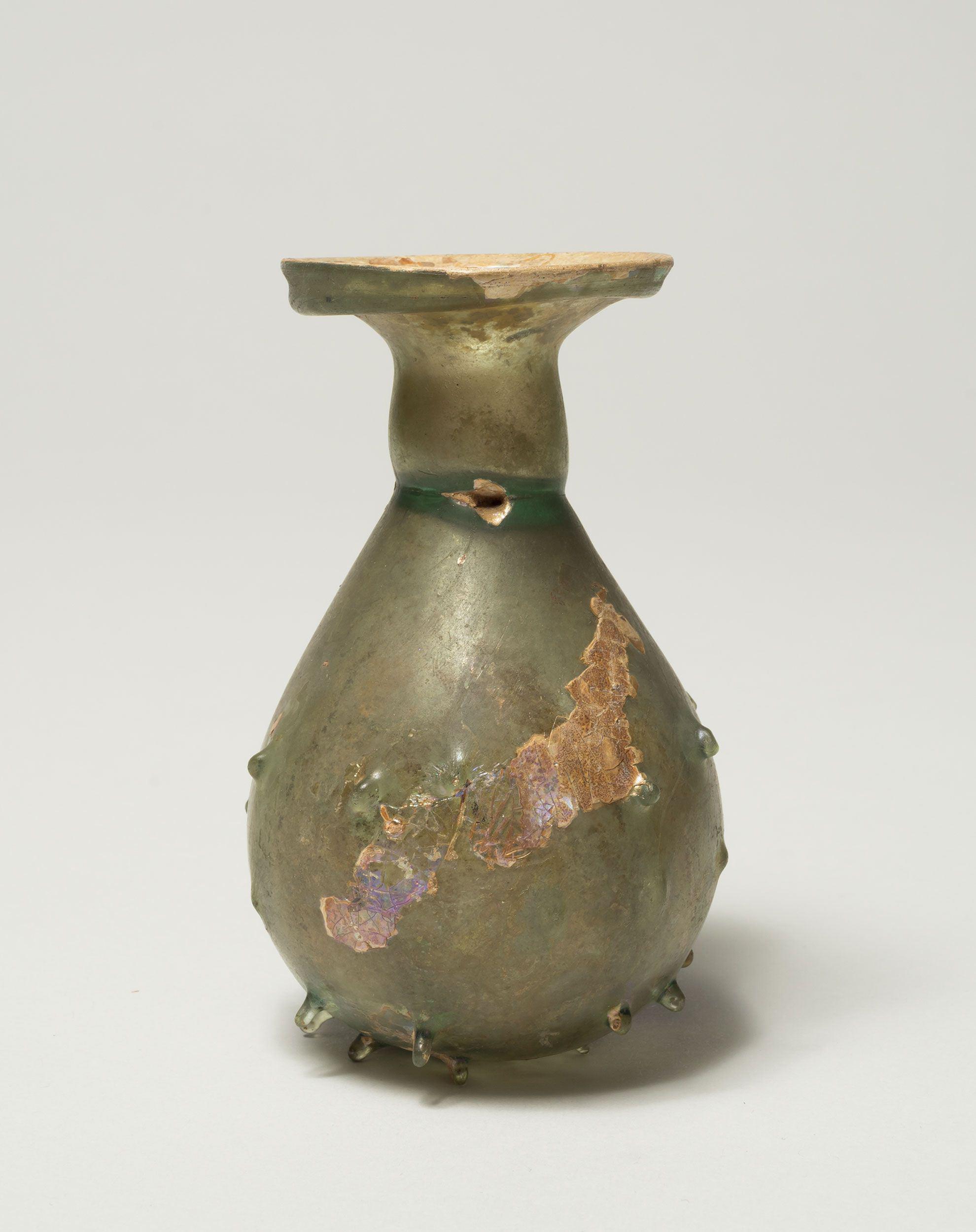
Work
Double-headed flask
Date
Between the mid-first and fourth century CE
Artist
Unknown
Place Made
Eastern Mediterranean
Medium
Mold-blown glass
Credit Line
Gift of Judith Riklis, 1981-256
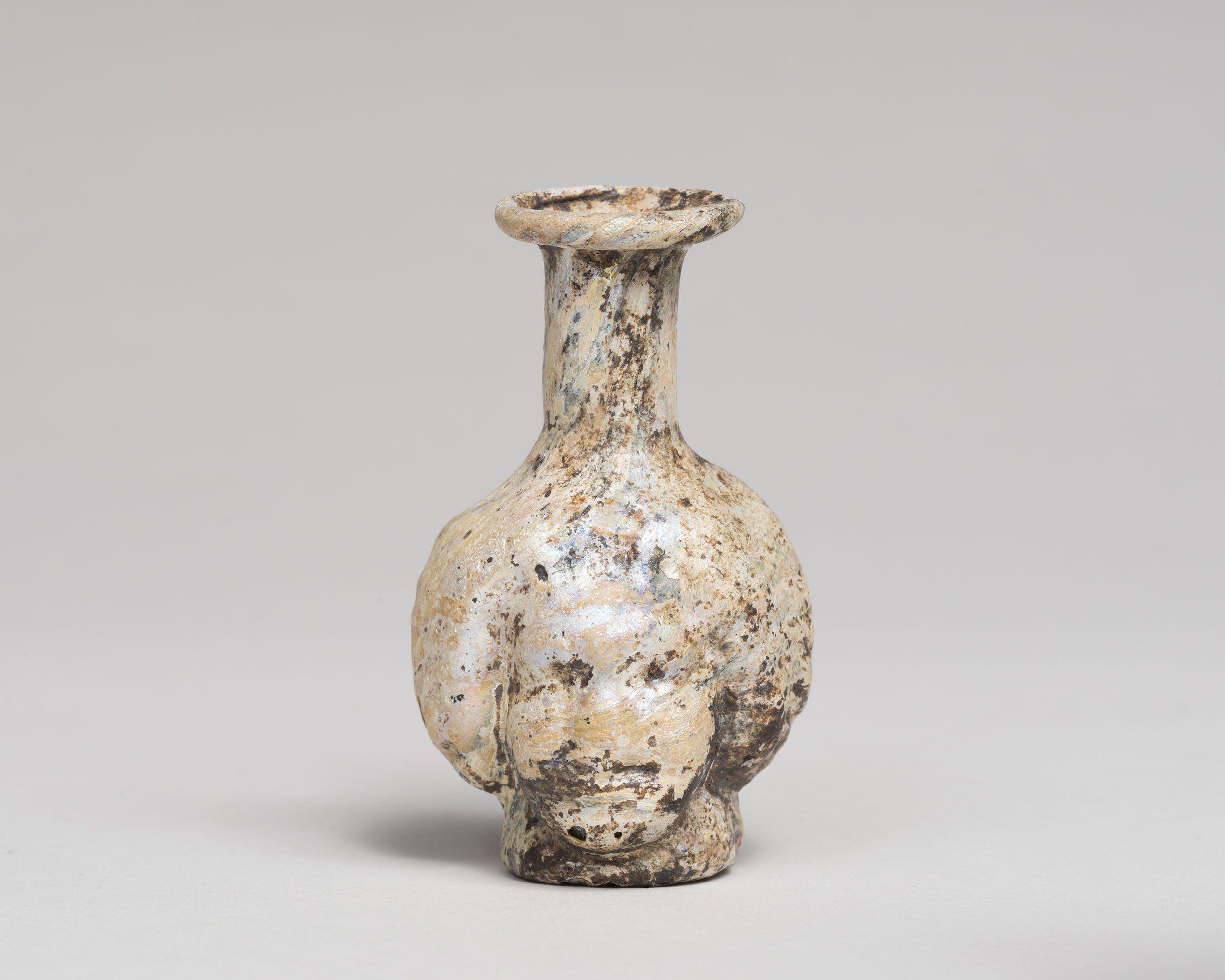
Work
Bottle
Date
Second or third century CE
Artist
Unknown
Place Made
Eastern Mediterranean
Medium
Free-blown glass
Credit Line
Gift of the Betty and Max Ratner Collection, 1981-79
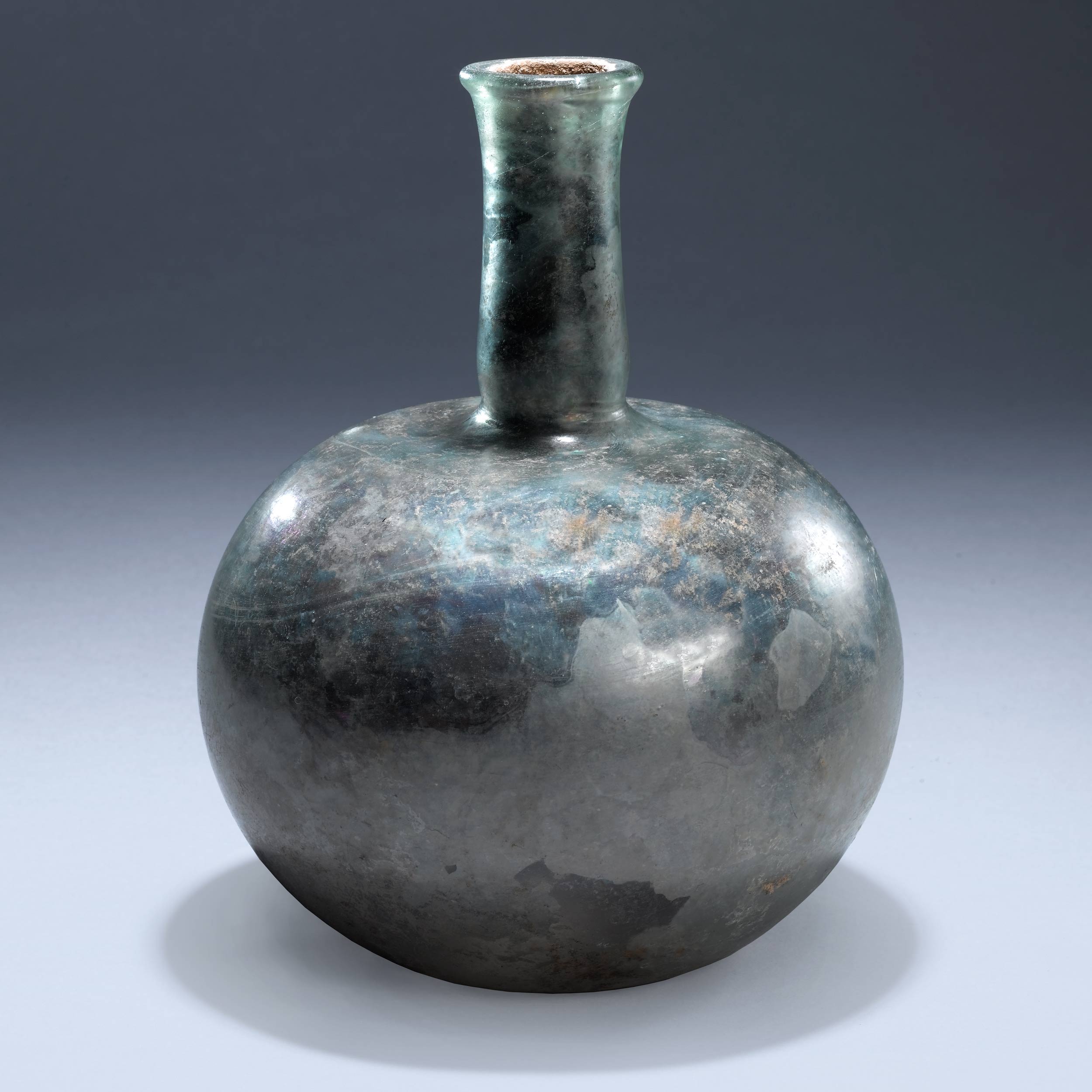
Work
Unguentarium
Date
Second or third century CE
Artist
Unknown
Place Made
Eastern Mediterranean
Medium
Free-blown and tooled glass
Credit Line
Gift of the Betty and Max Ratner Collection, 1981-81
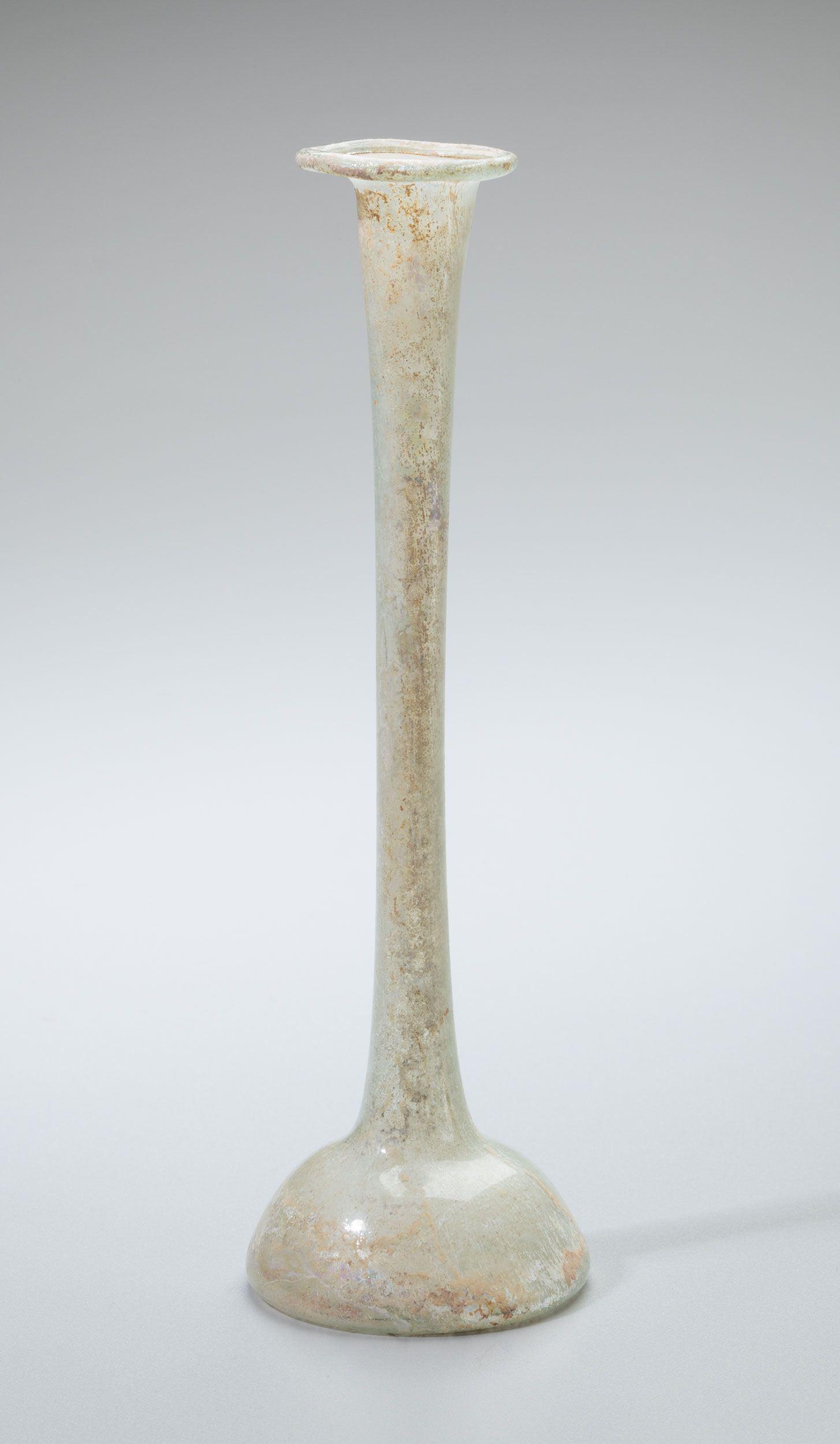
Work
Bottle
Date
First century CE
Artist
Unknown
Place Made
Eastern Mediterranean
Medium
Free-blown glass
Credit Line
Gift of Judith Riklis, 1981-273
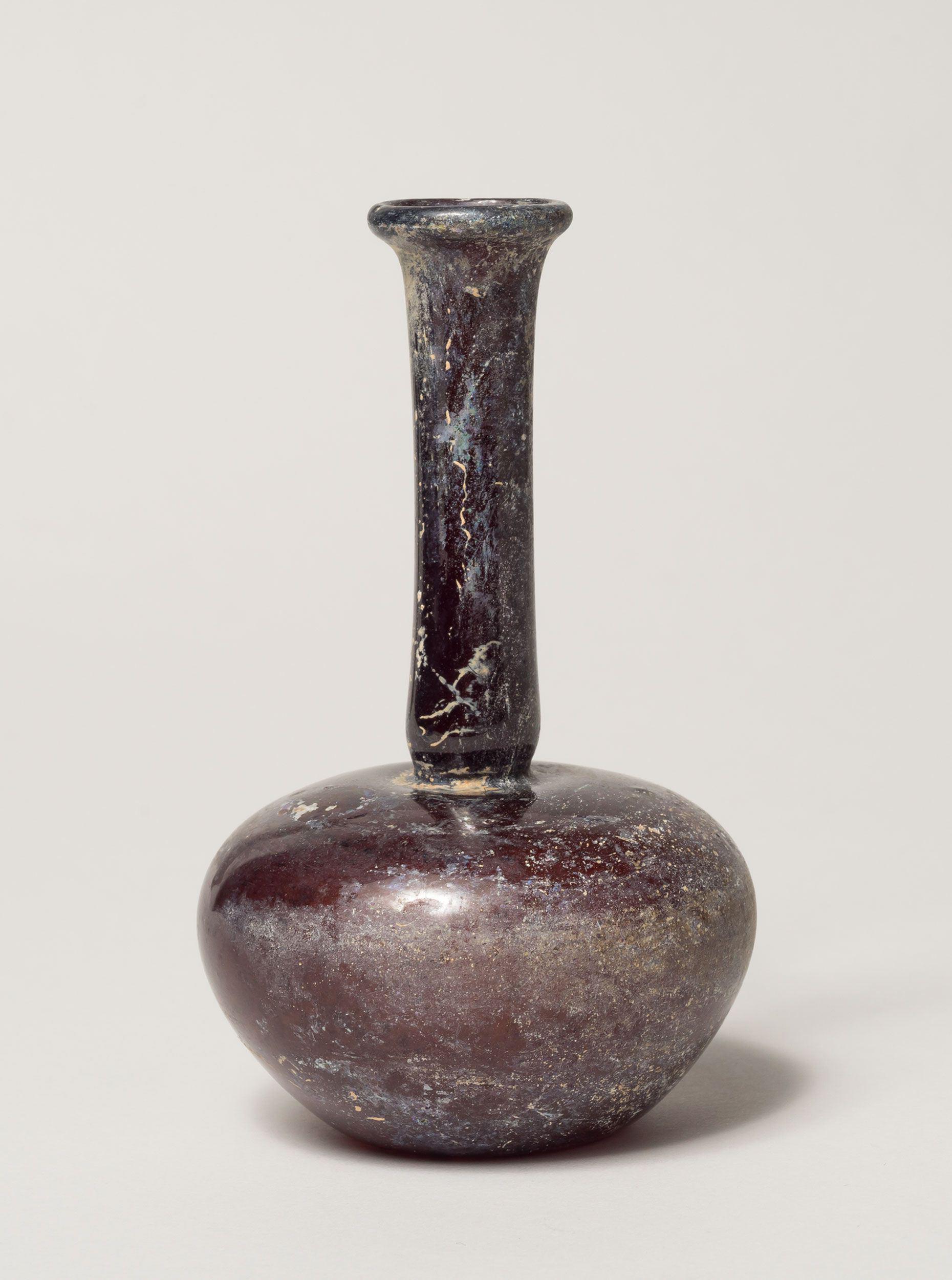
Work
Bottle
Date
First century CE
Artist
Unknown
Place Made
Eastern Mediterranean
Medium
Free-blown and wheel-incised glass
Credit Line
Gift of Judith Riklis, 1981-269
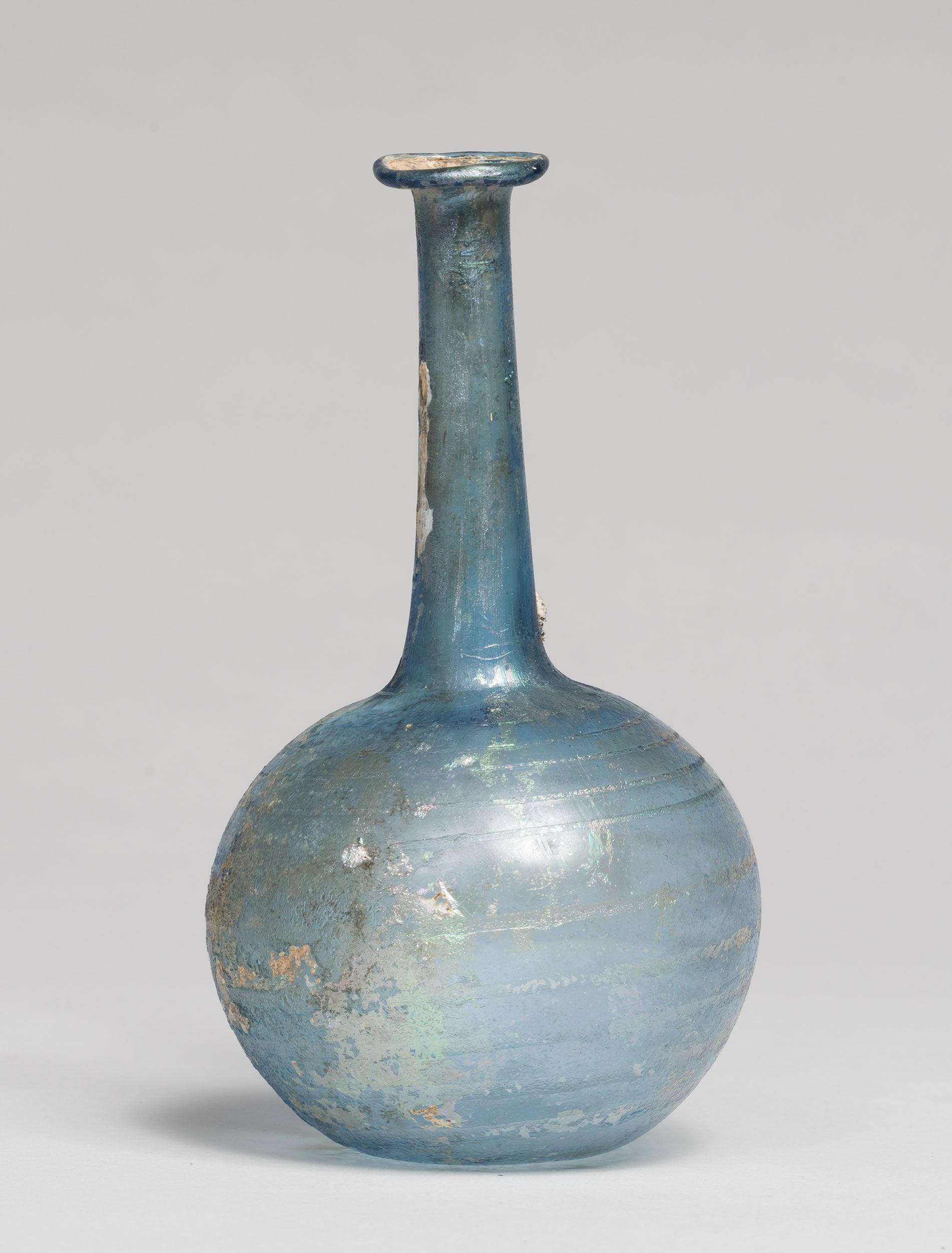
Work
Jar
Date
Third or fourth century CE
Artist
Unknown
Place Made
Syria, Lebanon, or Israel
Medium
Free-blown and tooled glass
Credit Line
Gift of Elaine and Harvey Rothenberg, JM 109-79
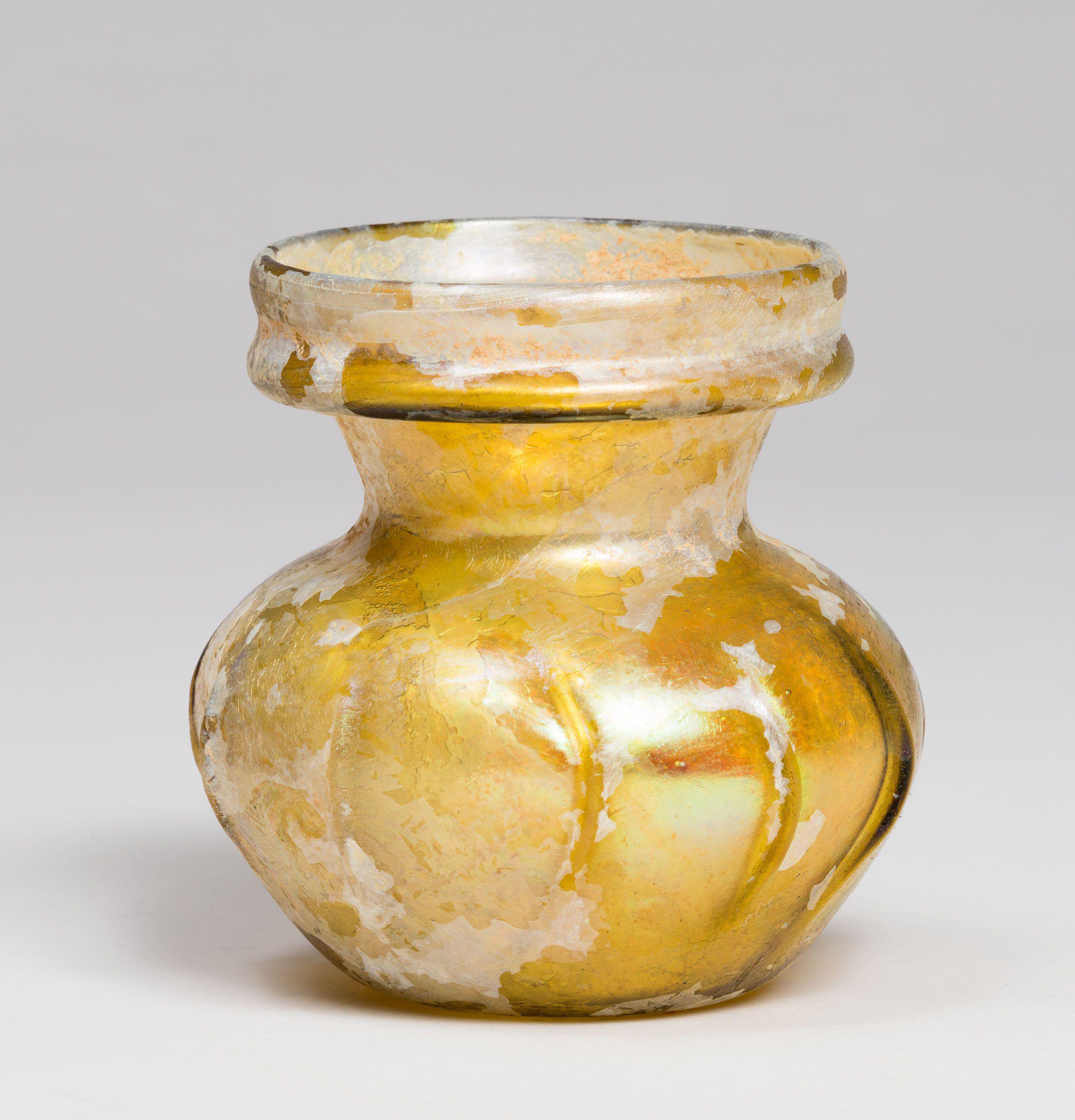
Work
Torah pointer
Date
1900–1950
Artist
Unknown
Place Made
Europe or the United States?
Medium
Carved wood
Credit Line
Gift of Dr. Harry G. Friedman, F 2609

Work
Torah pointer
Date
Nineteenth century
Artist
Unknown
Place Made
Europe or the United States?
Medium
Carved wood
Credit Line
Gift of Dr. Harry G. Friedman, F 829
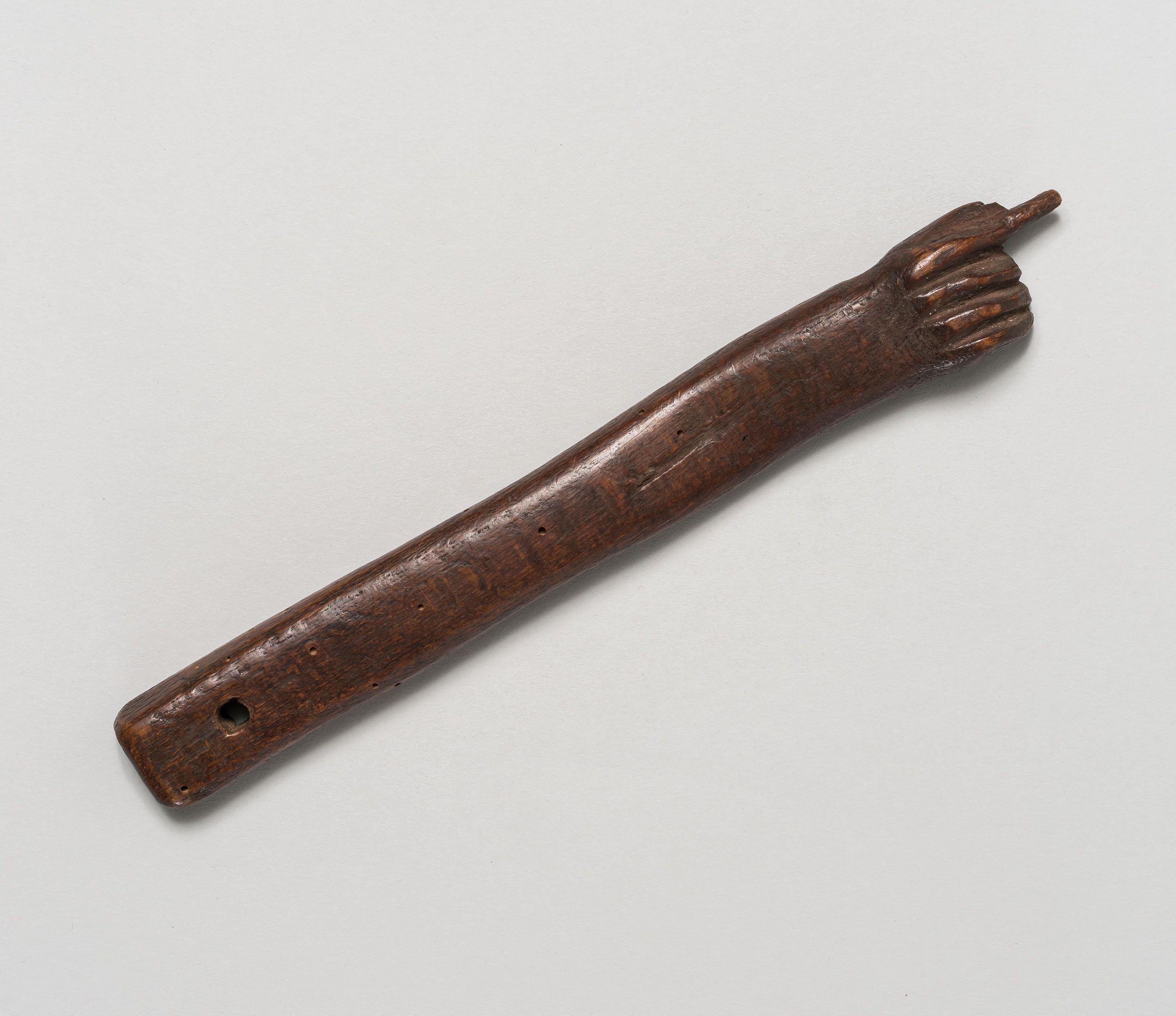
Work
Torah pointer
Date
Nineteenth century
Artist
Unknown
Place Made
Central Europe
Medium
Carved wood and rope
Credit Line
Gift of the Danzig Jewish Community, D 48

Work
Torah pointer
Date
Nineteenth–mid-twentieth century
Artist
Unknown
Place Made
Europe or the United States?
Medium
Carved wood
Credit Line
Gift of Dr. Harry G. Friedman, F 2569
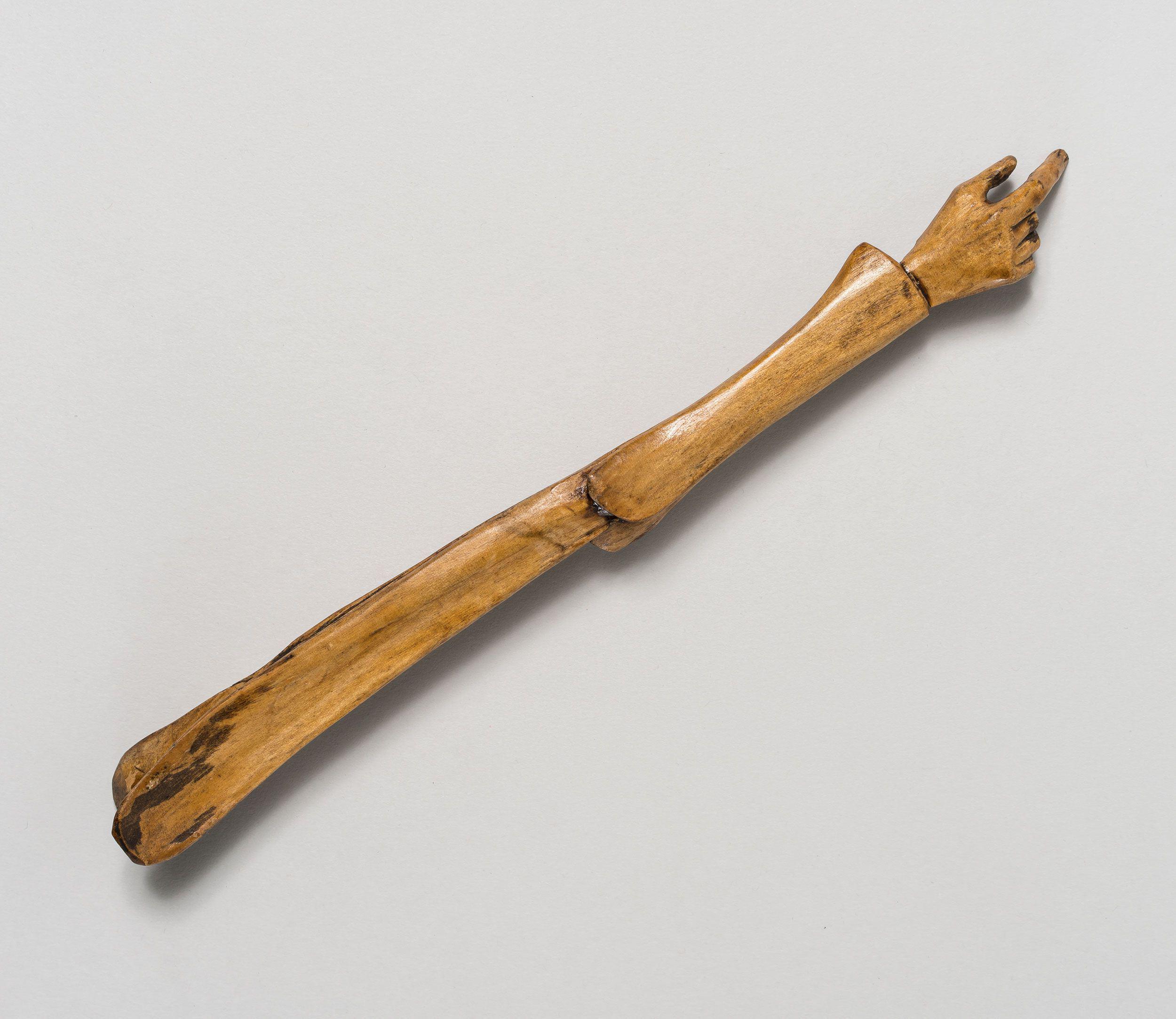
Work
Torah pointer
Date
Early twentieth century
Artist
Unknown
Place Made
Europe
Medium
Carved and turned wood
Credit Line
Gift of Dr. Harry G. Friedman, F 317
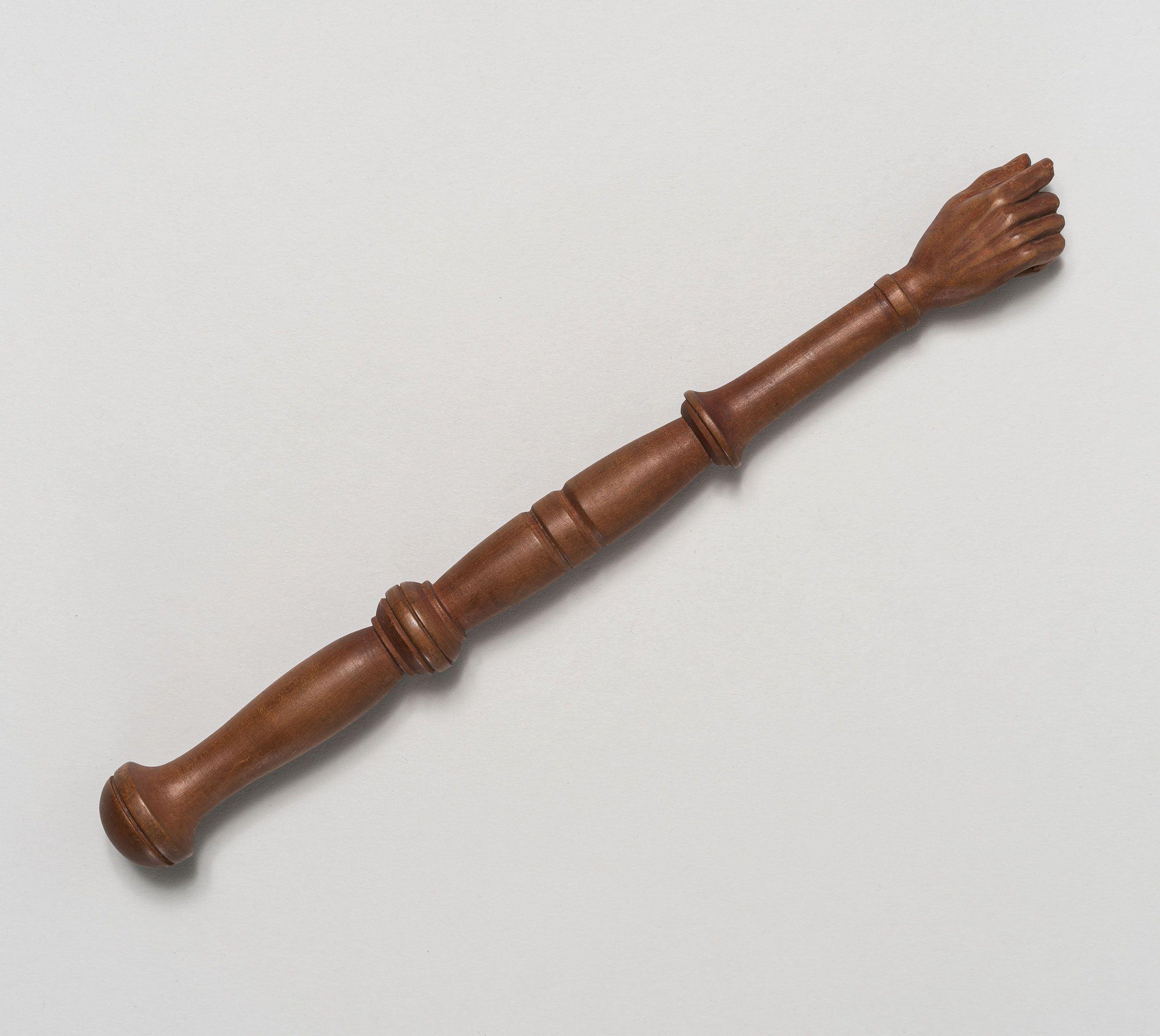
Work
Torah pointer
Date
Eighteenth or nineteenth century
Artist
Unknown
Place Made
Germany
Medium
Carved wood
Credit Line
Jewish Cultural Reconstruction, JM 14-52
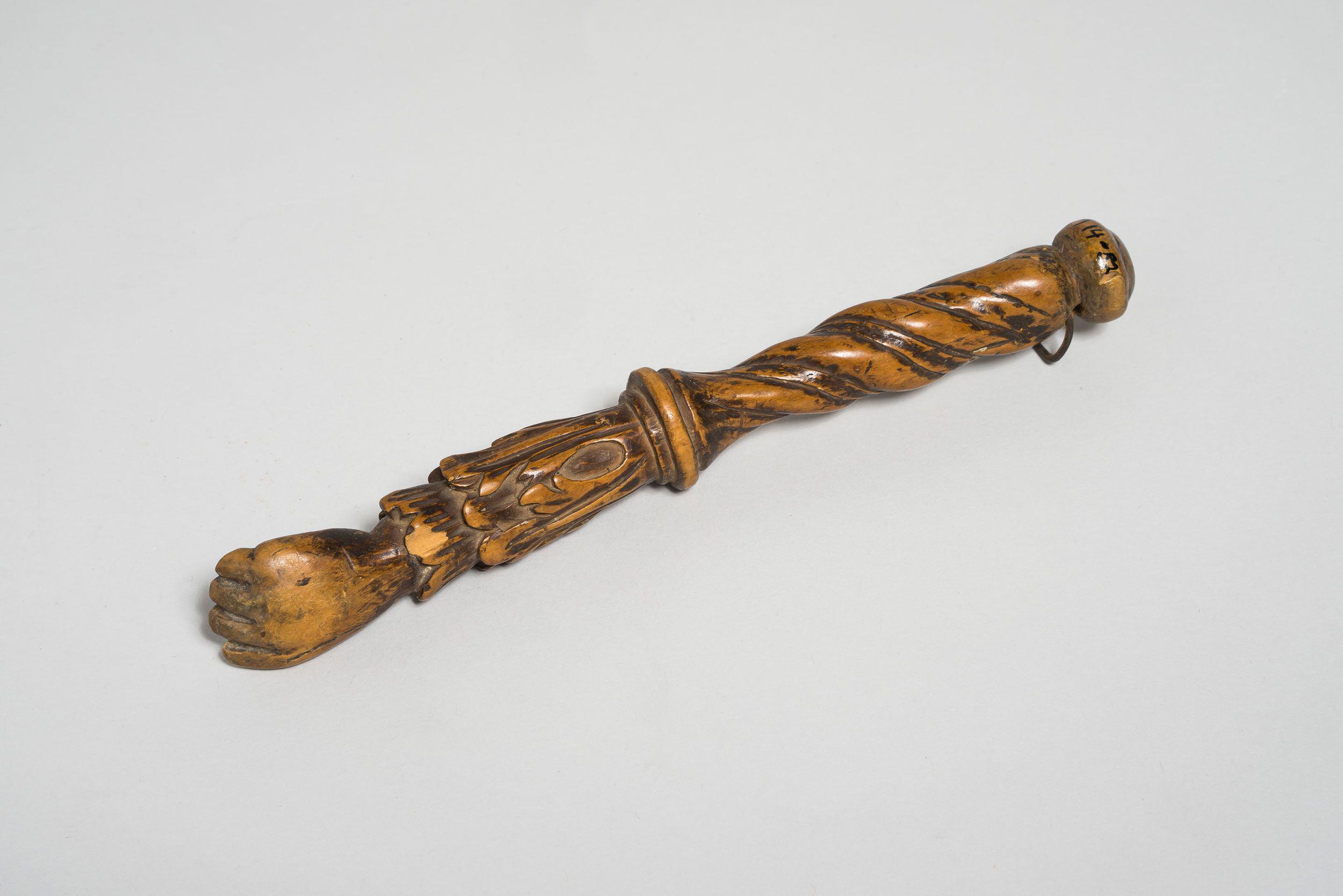
Work
Torah pointer
Date
Nineteenth century?
Artist
Unknown
Place Made
Europe or the United States?
Medium
Carved, turned, and pierced horn and wood?
Credit Line
Gift of Dr. Harry G. Friedman, F 5028
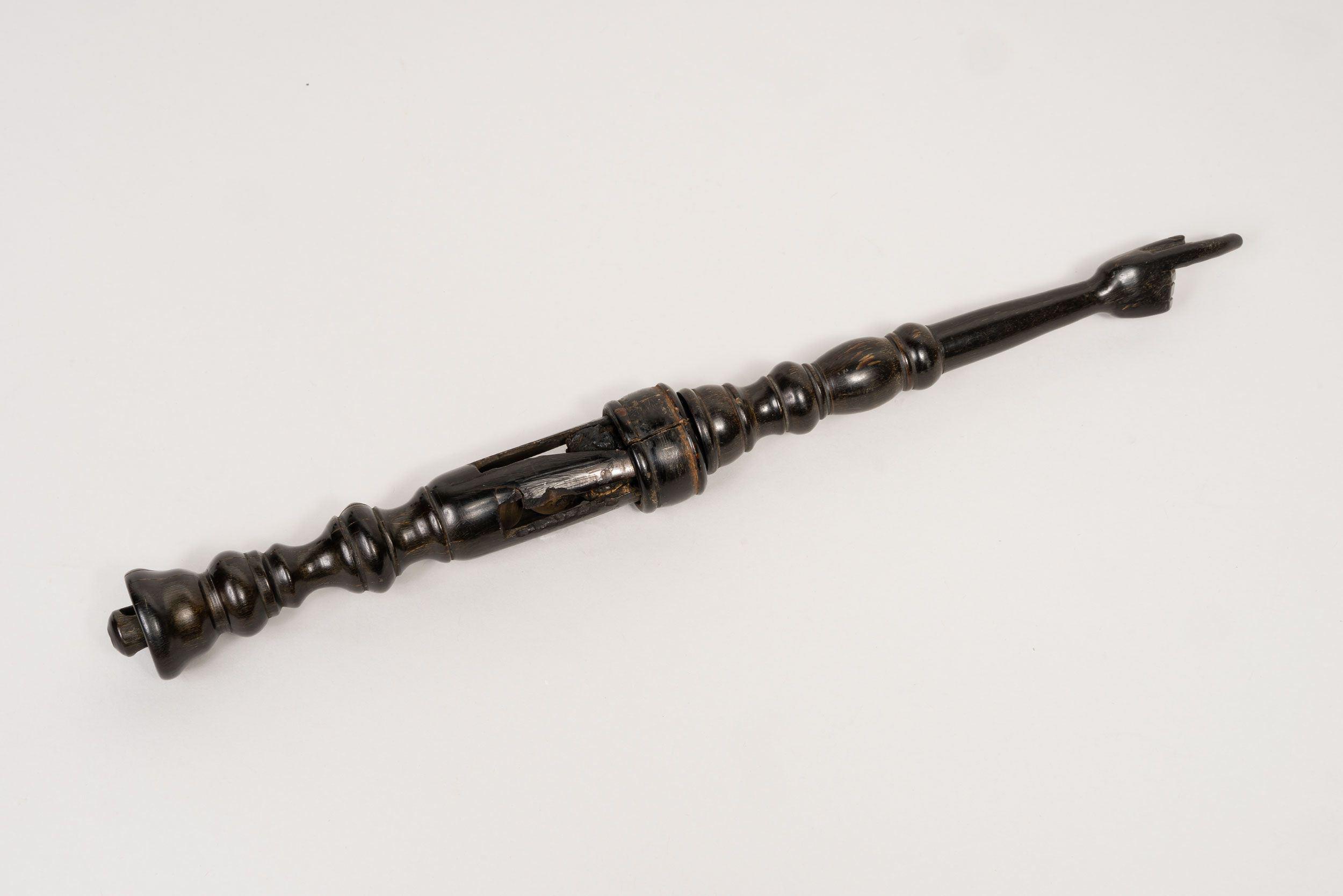
Work
Torah pointer
Date
Nineteenth century?
Artist
Unknown
Place Made
Poland?
Medium
Turned wood, carved bone, and brass
Credit Line
The Rose and Benjamin Mintz Collection, M 373
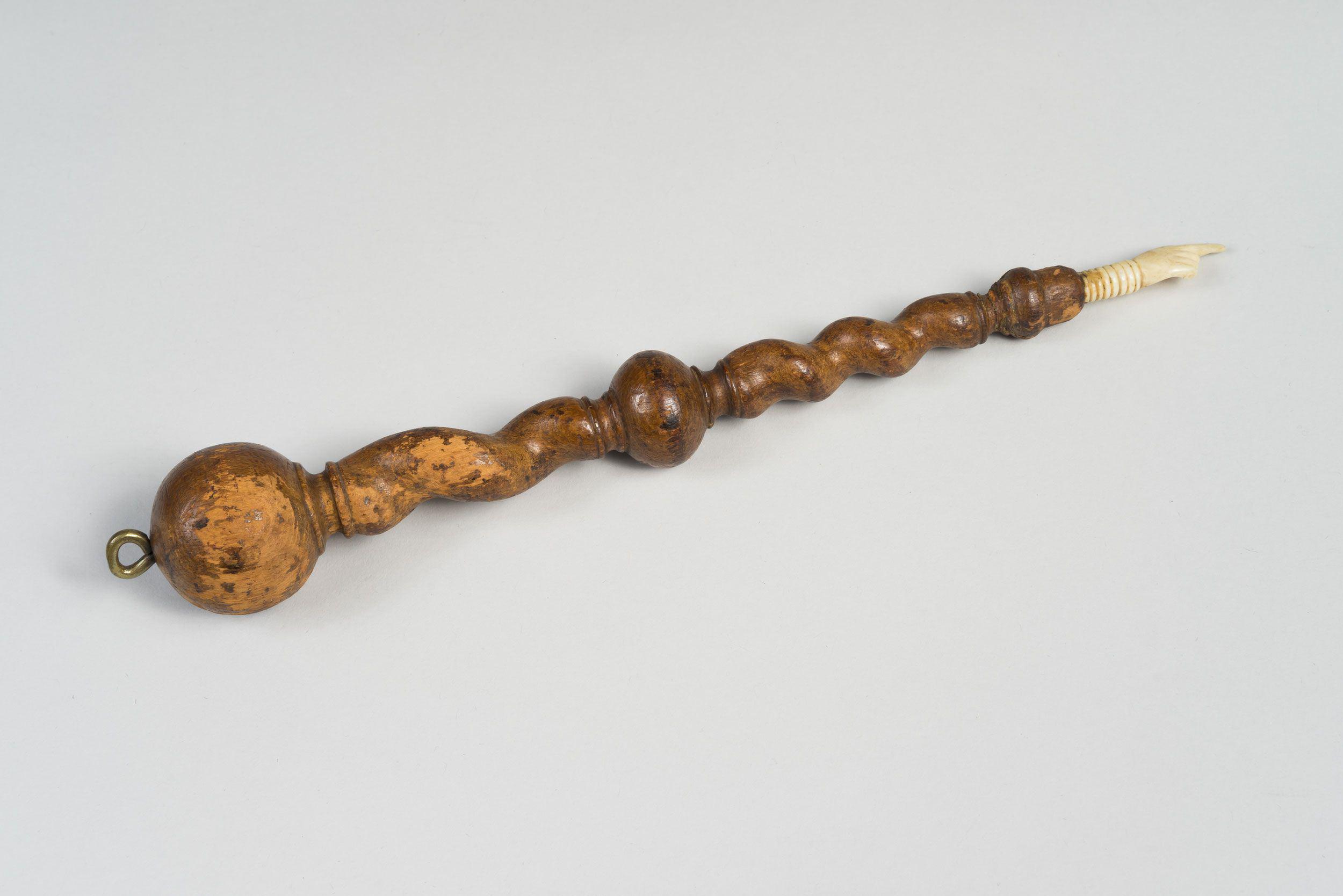
Work
Torah pointer
Date
Nineteenth century
Artist
Unknown
Place Made
Poland or Germany
Medium
Carved, gessoed, and painted wood and glass; silver chain
Credit Line
The Rose and Benjamin Mintz Collection, M 426

Work
Torah pointer
Date
Twentieth century
Artist
Unknown
Place Made
Egypt
Medium
Cast, engraved, and traced silver
Credit Line
Gift of Dr. Harry G. Friedman, F 5403

Work
Torah pointer
Date
1817–18
Artist
Unknown
Place Made
Amsterdam
Medium
Cast silver and diamond
Credit Line
Gift of Rupert L. Joseph, JM 6-53
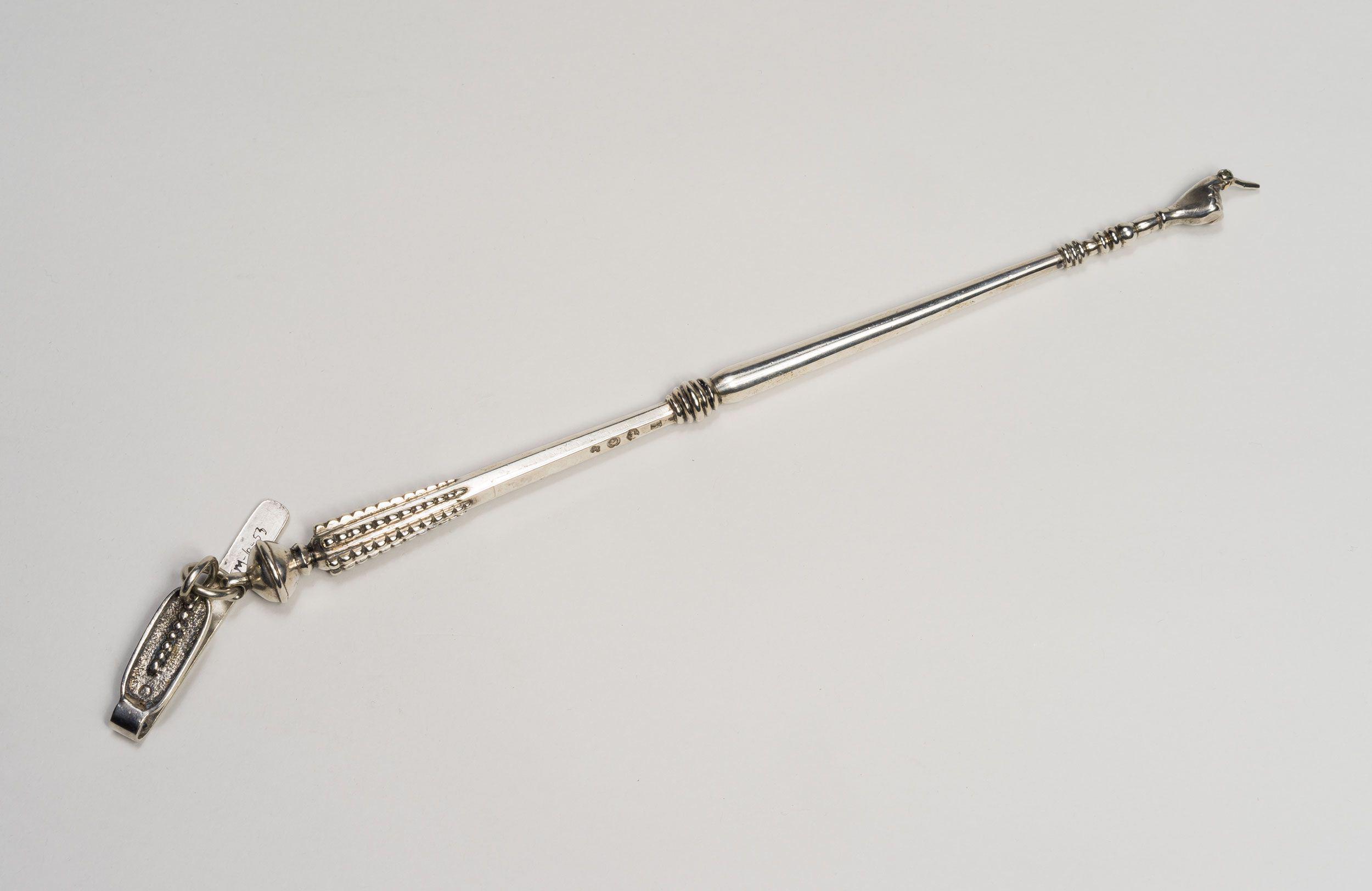
Work
Torah pointer
Date
Mid-nineteenth century?
Artist
Unknown
Place Made
Privigye?, Hungary
Medium
Cast, traced, and engraved silver
Credit Line
Gift of Dr. Harry G. Friedman, F 4509
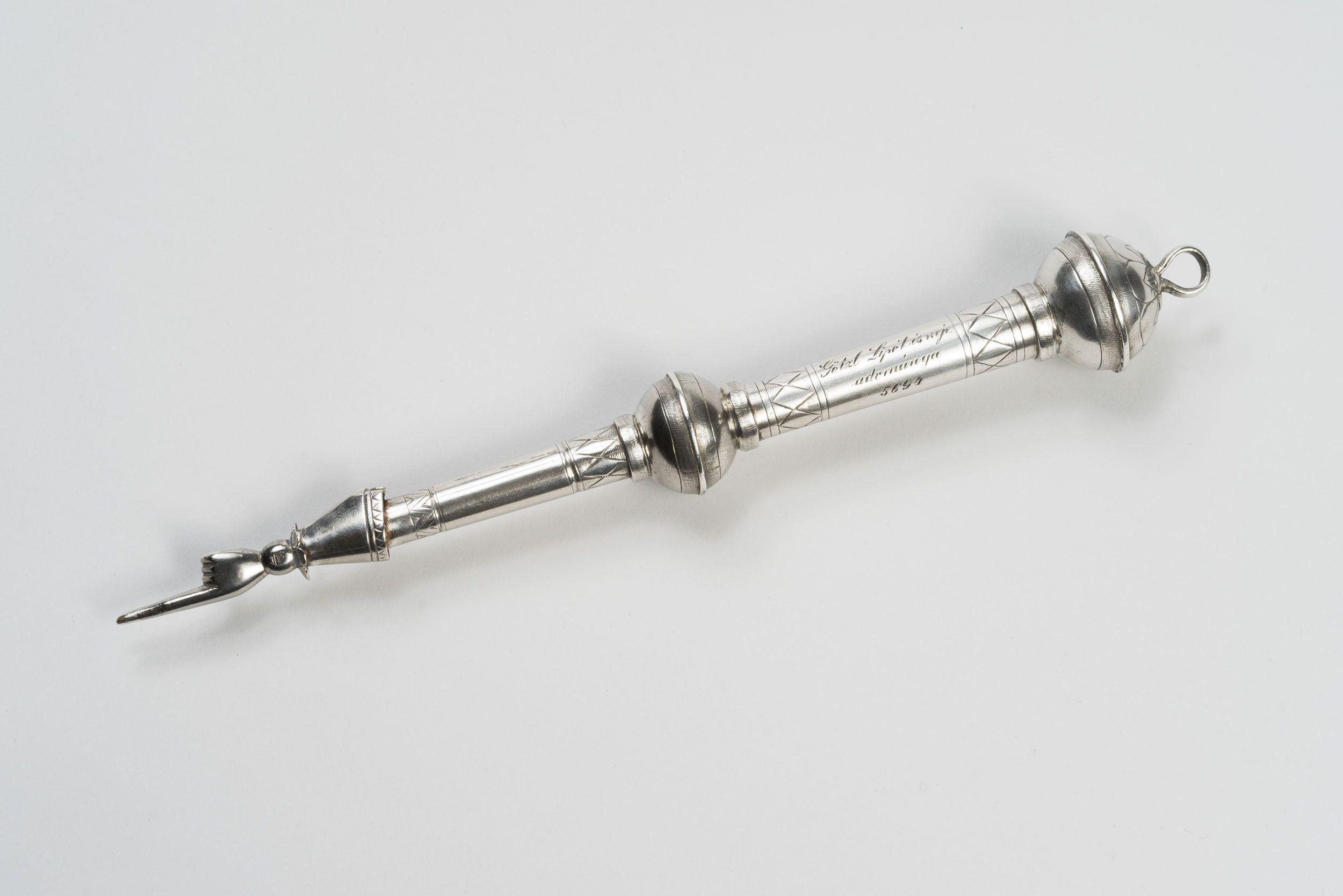
Work
Torah pointer
Date
Late eighteenth or early nineteenth century
Artist
Unknown
Place Made
Northern Germany
Medium
Cast, pierced, and chased silver
Credit Line
1976-24

Work
Torah pointer
Date
Early twentieth century
Artist
Unknown
Place Made
Jerusalem
Medium
Turned, carved, and pierced wood, bone inlay, carved mother-of-pearl, brass, iron, and cord
Credit Line
Gift of Dr. Harry G. Friedman, F 4205

Work
Torah pointer
Date
Between 1872 and 1922
Artist
Unknown
Place Made
Vienna
Medium
Silver, coral, and semiprecious stones
Credit Line
Gift of Dr. Harry G. Friedman, F 934

Work
Torah pointer
Date
Late nineteenth or early twentieth century
Artist
Unknown
Place Made
Eastern Europe
Medium
Carved and inlaid bone, horn, and cast silver
Credit Line
Gift of Dr. Harry G. Friedman, F 4603
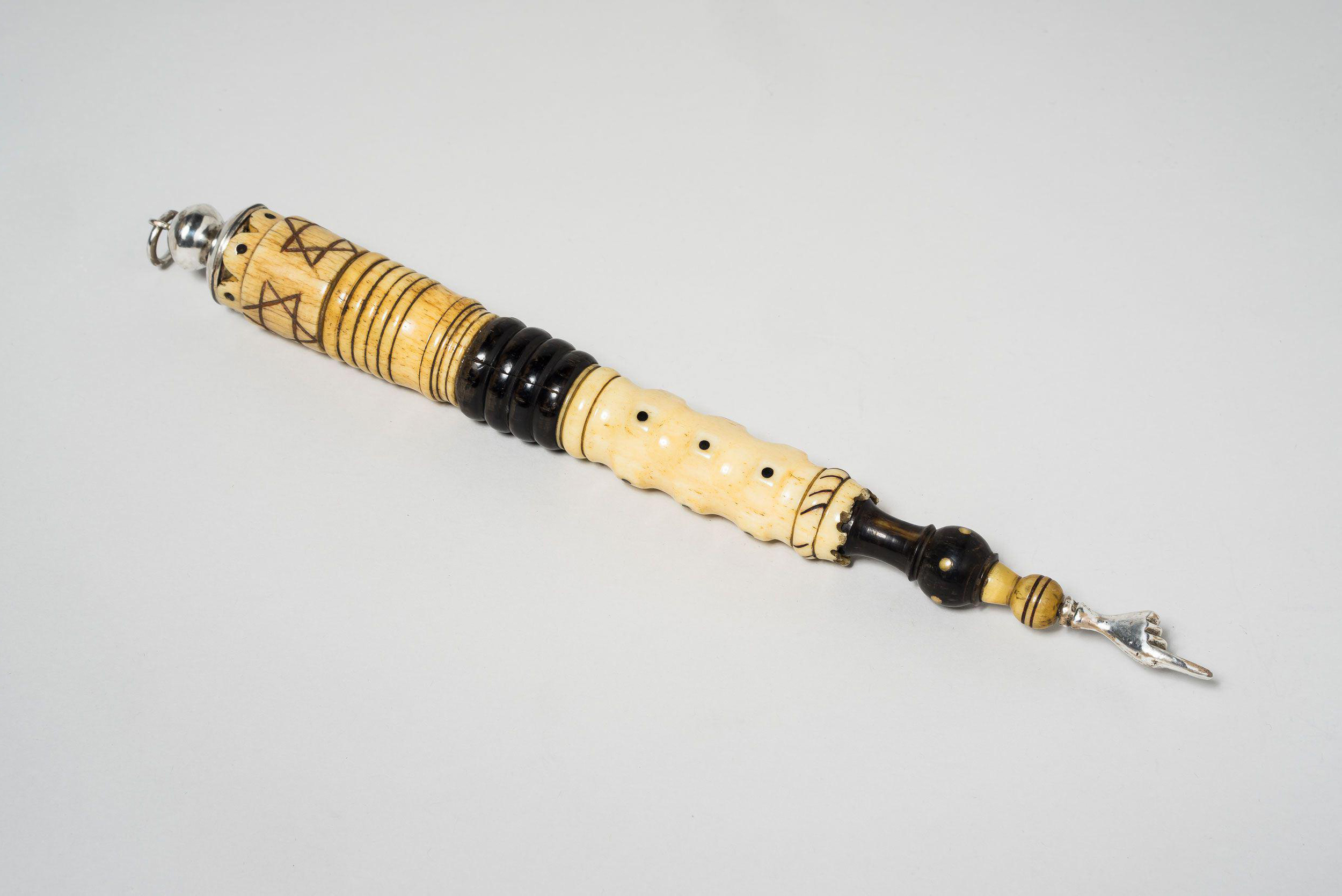
Work
Torah pointer
Date
Late eighteenth or early nineteenth century
Artist
Unknown
Place Made
Galicia? (now in Poland and Ukraine)
Medium
Cast, chased, and engraved silver
Credit Line
Gift of Dr. Harry G. Friedman, F 2590
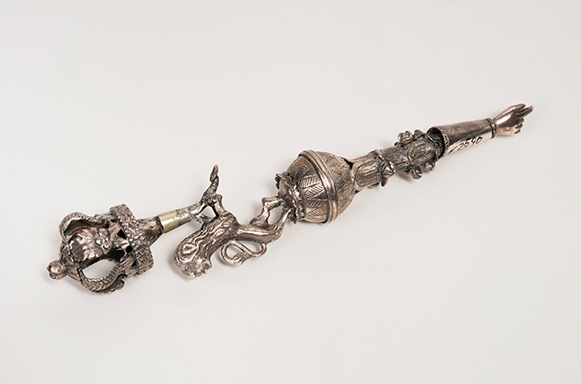
Work
Torah pointer
Date
Nineteenth century?
Artist
Unknown
Place Made
Europe?
Medium
Carved ivory
Credit Line
Gift of M. Vaxer, S 1193
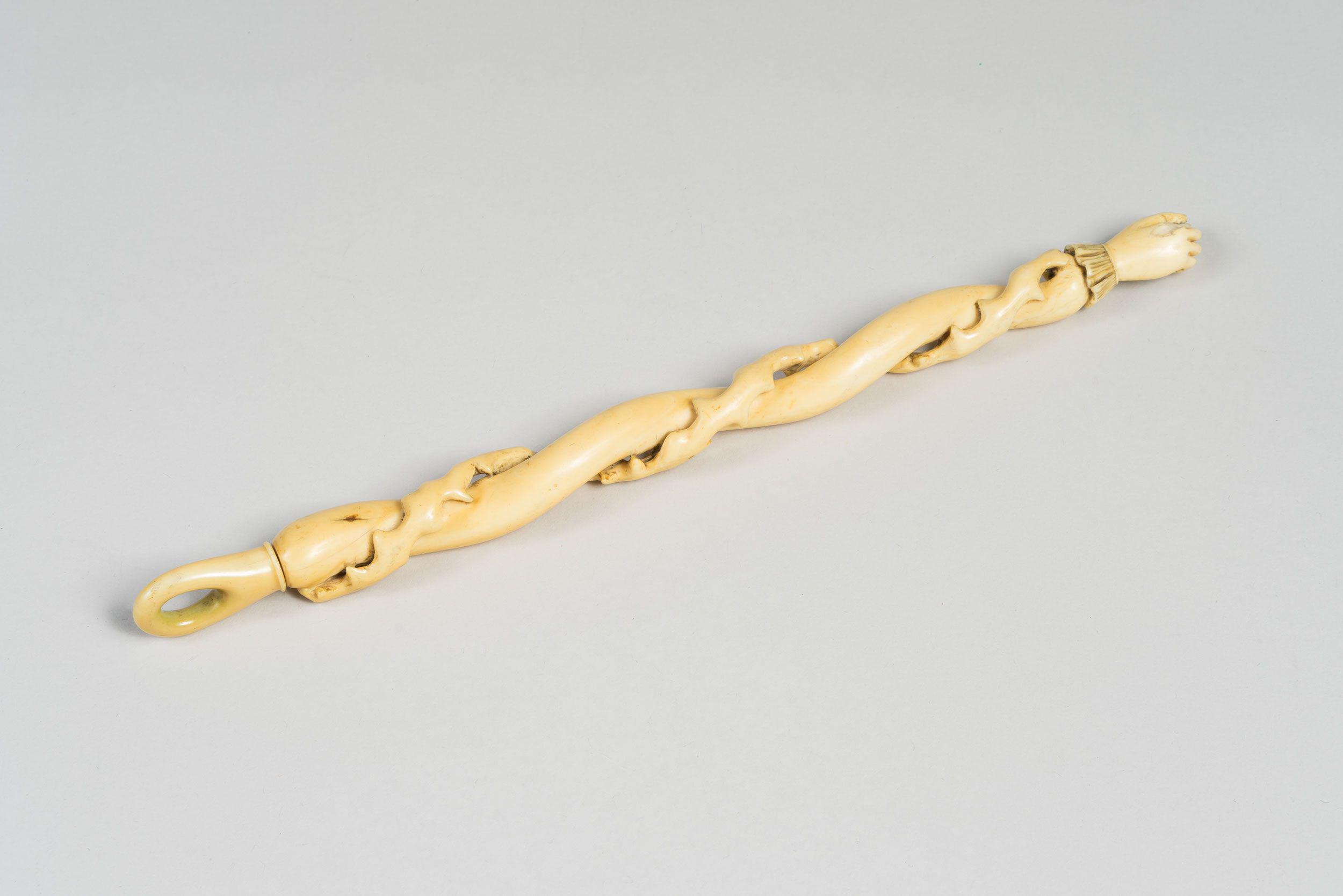
Work
Torah pointer
Date
1950s
Artist
Moshe Smilovici; Israeli, born in Romania, 1912, died in 1962
Place Made
Israel
Medium
Die-stamped and chased silver, carved ivory?, and semiprecious stones
Credit Line
Gift of Dr. Harry G. Friedman, F 4185c
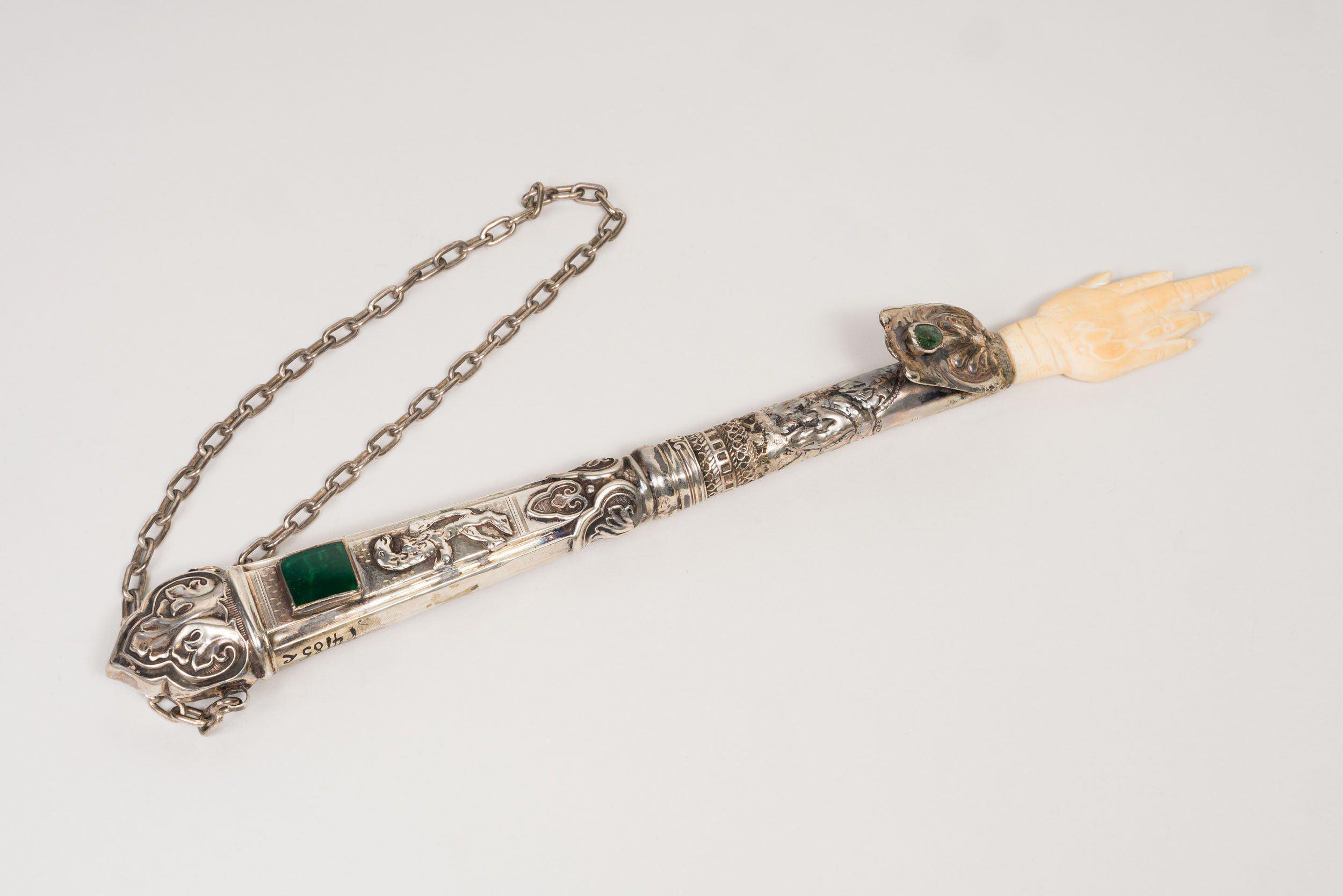
Work
Purim noisemaker
Date
Late nineteenth century
Artist
Unknown
Place Made
Volochysk, Ukraine
Medium
Painted wood
Credit Line
Gift of Allen Erlbamm in memory of his grandfather George Golkin, JM 2-69

Work
Purim noisemaker
Date
Nineteenth century
Artist
Unknown
Place Made
Poland
Medium
Carved and infilled wood
Credit Line
The Rose and Benjamin Mintz Collection, M 465

Work
Purim noisemaker
Date
Late nineteenth century?
Artist
Unknown
Place Made
Poland?
Medium
Tin-plated and die-stamped iron and wood
Credit Line
X10

Work
Purim noisemaker
Date
Nineteenth century?
Artist
Unknown
Place Made
Poland?
Medium
Wood and copper alloy
Credit Line
Gift of Dr. Harry G. Friedman, F 2607
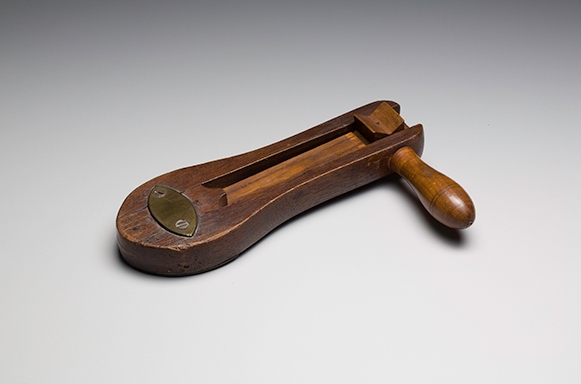
Work
Shoe Grogger (The Noisemaker)
Date
2002
Artist
András Böröcz; American, born in Hungary in 1956
Place Made
New York
Medium
Carved walnut
Credit Line
Purchase: Contemporary Judaica Acquisitions Committee Fund, 2003-8
The contemporary artist András Böröcz has created a series of wood sculptures related to the festival of Purim. He became fascinated with the grogger, a hand-held noisemaker used in the synagogue during the reading of the Book of Esther to blot out the name of the villain, Haman. In some Jewish communities, people write Haman’s name on the soles of their shoes in order to stamp it out whenever it is mentioned. Böröcz’s mechanical shoe-stomping apparatus makes the requisite noise when the handle is cranked.
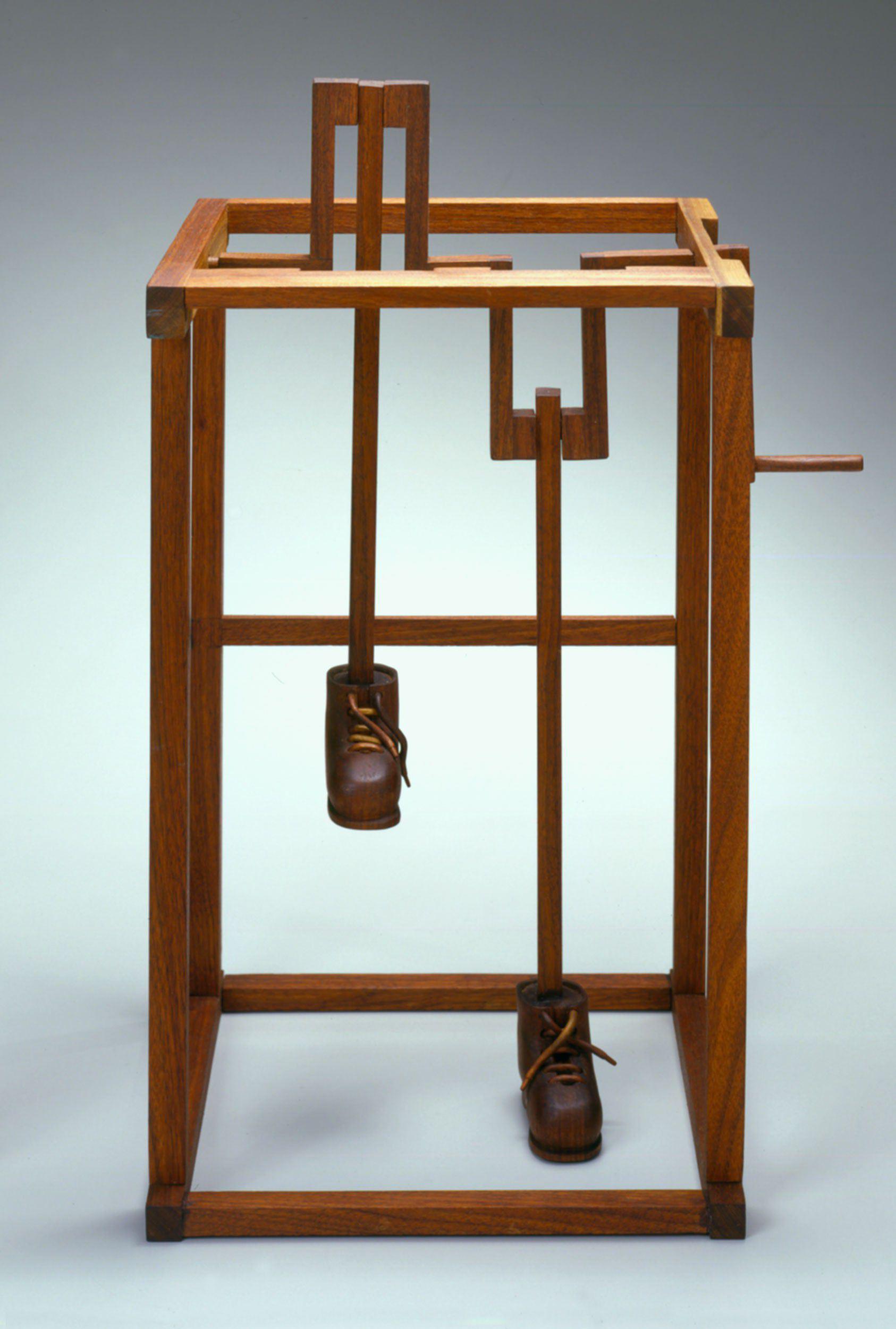
Work
Pocket watch
Date
Late nineteenth or early twentieth century
Artist
Unknown
Place Made
France
Medium
Silver, glass, and gilt metal
Credit Line
U 7304
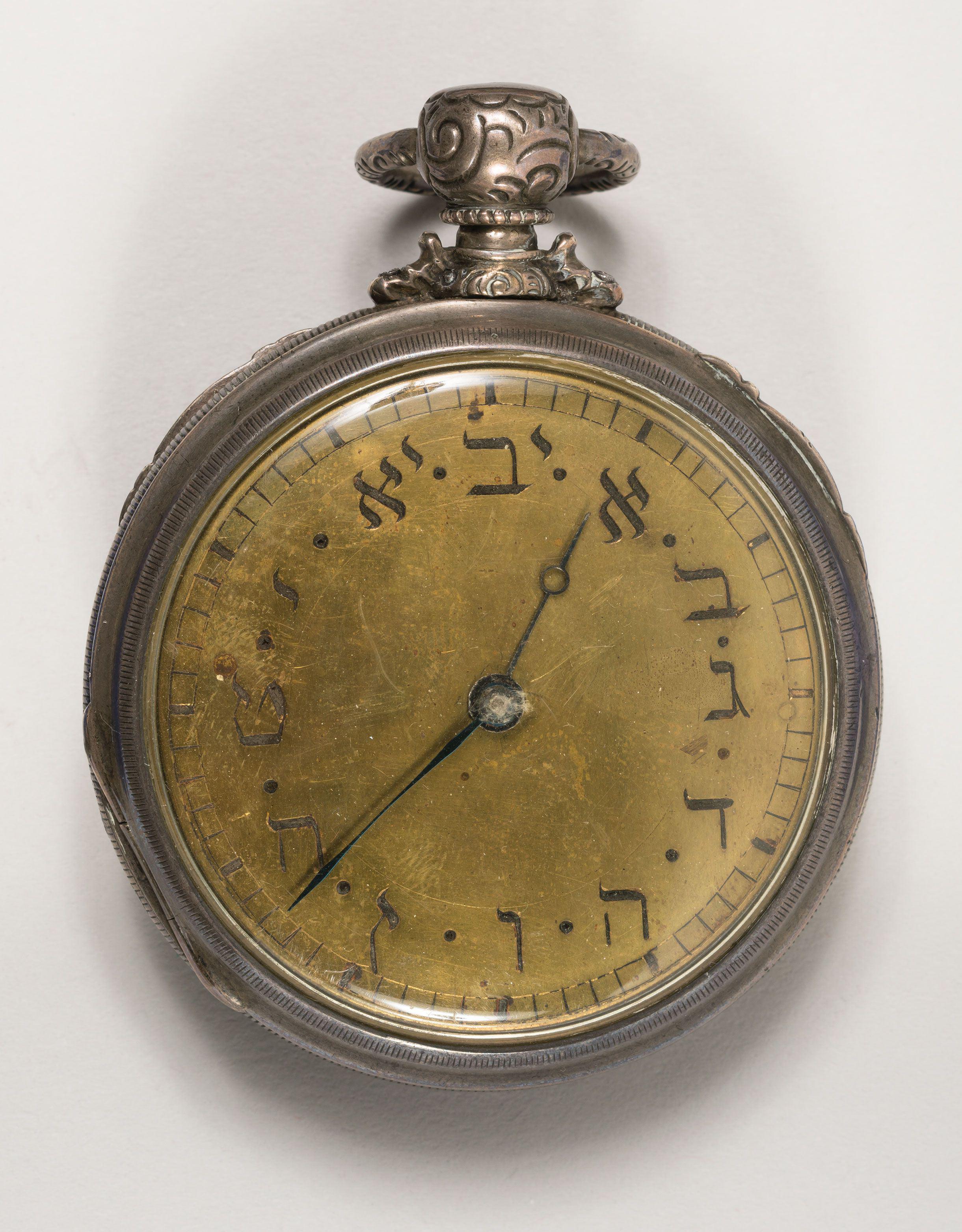
Work
Pocket watch
Date
c. 1900
Artist
Firm of Léon Lévy Frères Pierce, founded in 1883, closed in the early 1980s, reopened in 2005
Place Made
Biel/Bienne, Switzerland
Medium
Silver-plated, cast, engraved, gilded, and painted copper alloy
Credit Line
Gift of Dr. Harry D. Friedman, F 965
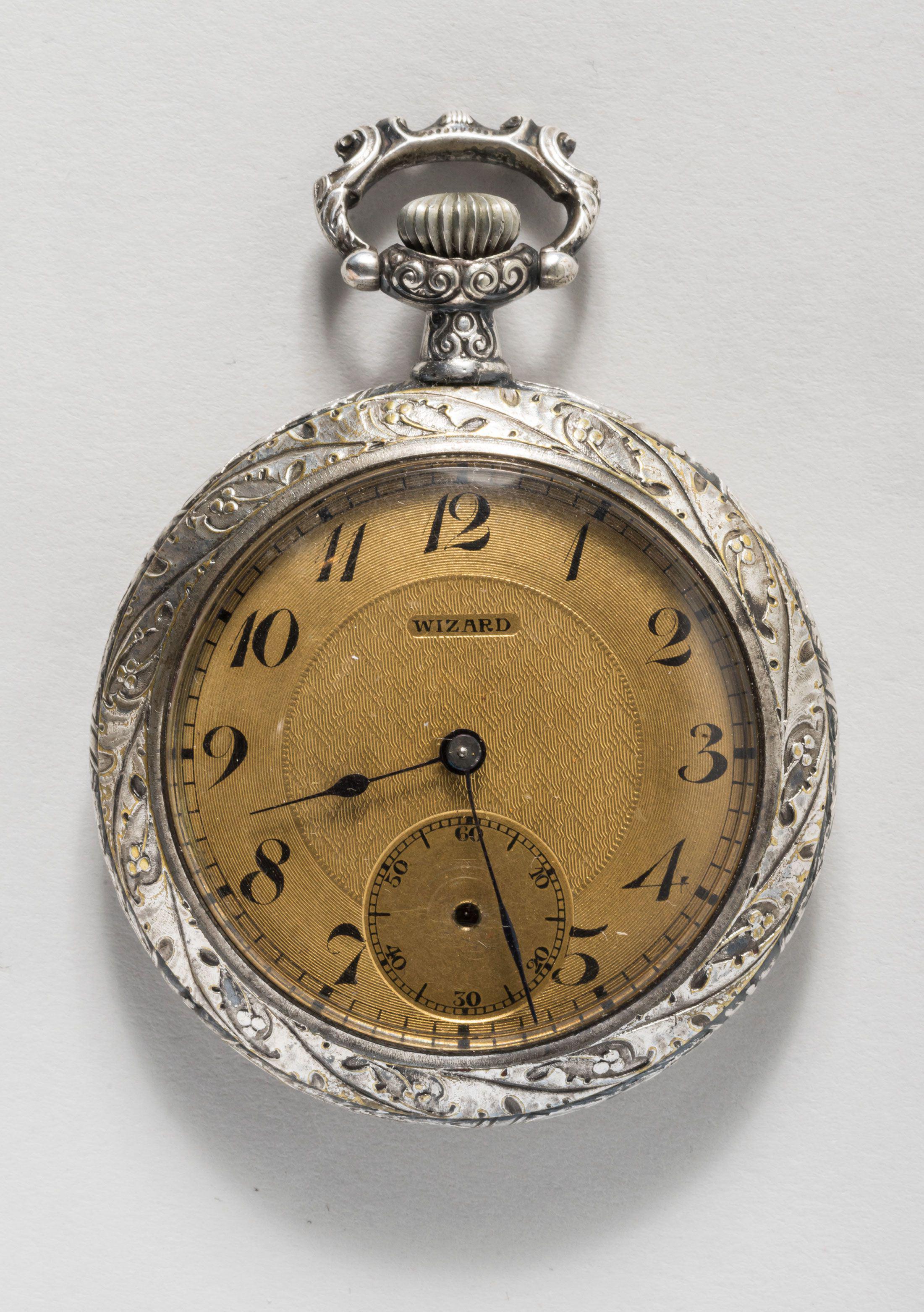
Work
Pocket watch
Date
Early twentieth century
Artist
Unknown
Place Made
Switzerland
Medium
Silver, niello, and enamel
Credit Line
U 8023
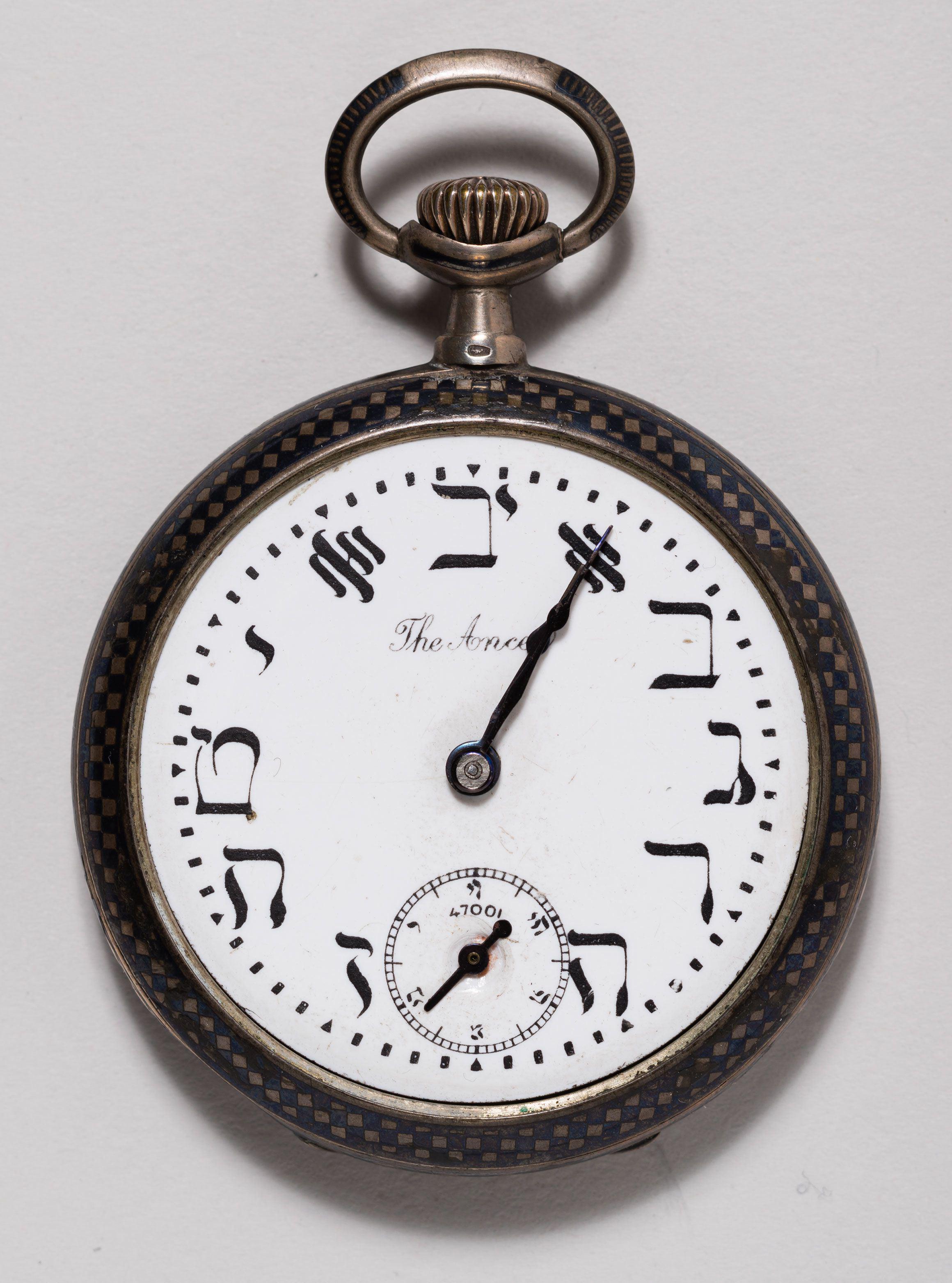
Work
Perpetual calendar button
Date
c. 1877
Artist
Unknown
Place Made
Paris
Medium
Silver-plated and cast copper alloy and ink on parchment
Credit Line
Gift of Dr. Harry G. Friedman, F 3808

Work
Clock
Date
Mid-nineteenth century
Artist
Anton List; Austrian, born in 1799, died in 1876
Place Made
Vienna
Medium
Wood, copper alloy, enamel, and engraved bone
Credit Line
Gift of Dr. Harry G. Friedman, F 2714

Work
Clock
Date
End of the nineteenth or early twentieth century
Artist
Unknown
Place Made
Europe
Medium
Cast, punched, and chased copper alloy
Credit Line
Gift of Norman F. Goetz through Dr. Harry G. Friedman, F 2555
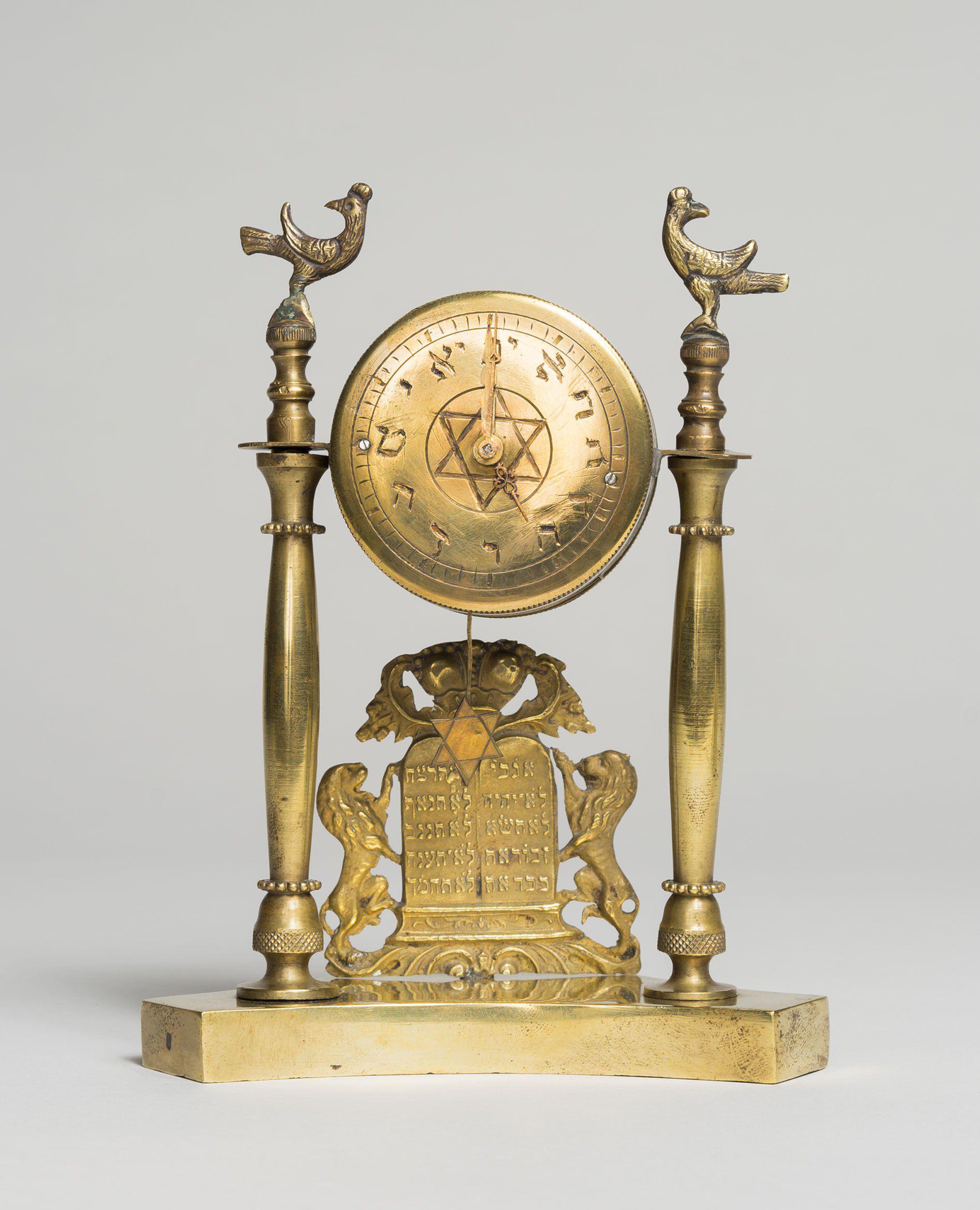
Work
Clock
Date
Mid-nineteenth century
Artist
Charles Aimé Sandoz; Swiss, born in 1819
Place Made
Vienna or Geneva
Medium
Elephant ivory and engraved tortoiseshell
Credit Line
Gift of Dr. Harry G. Friedman, F 2715
